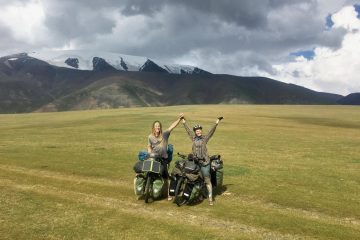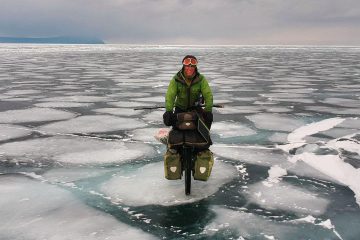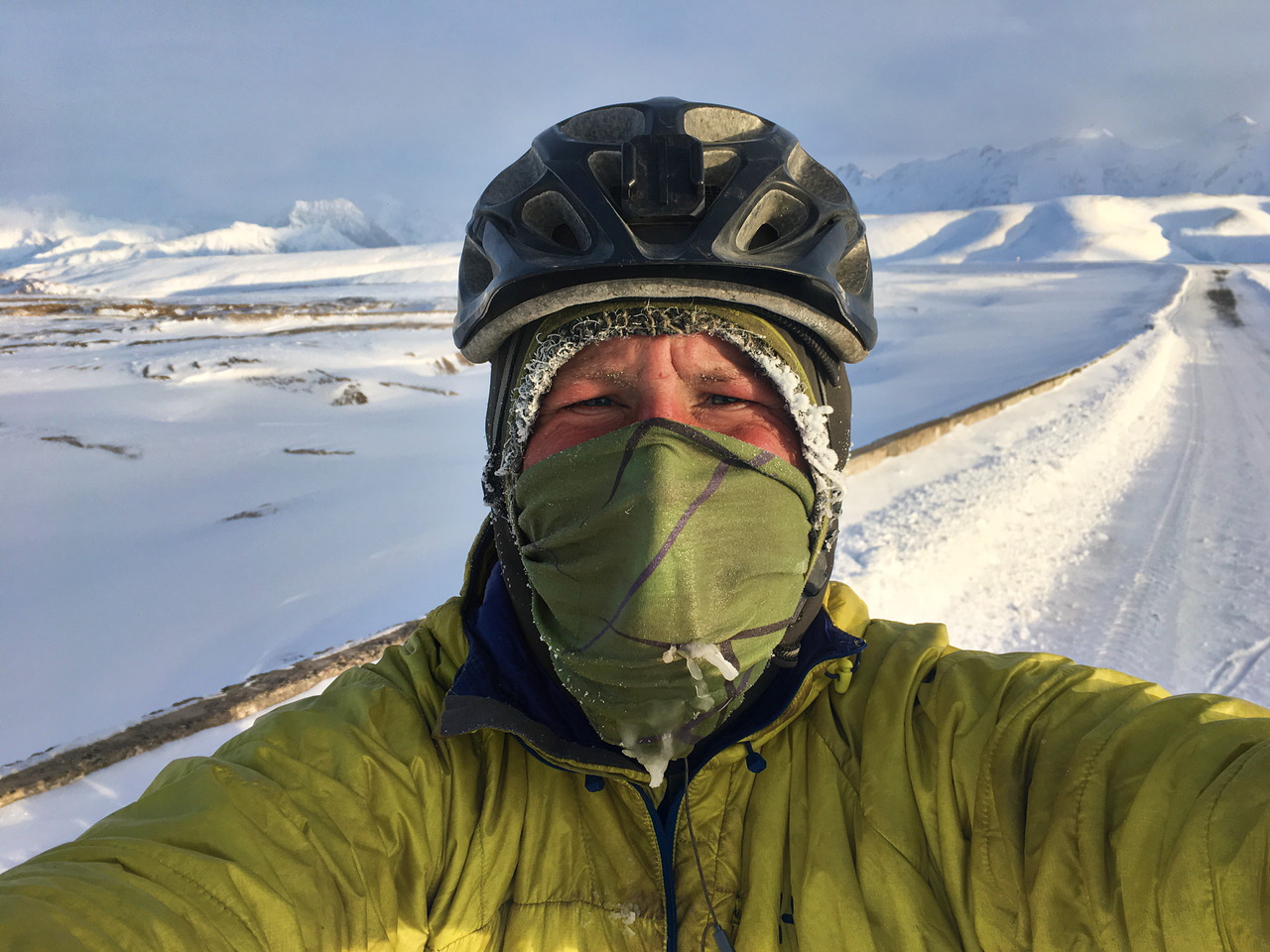Winter in Siberia
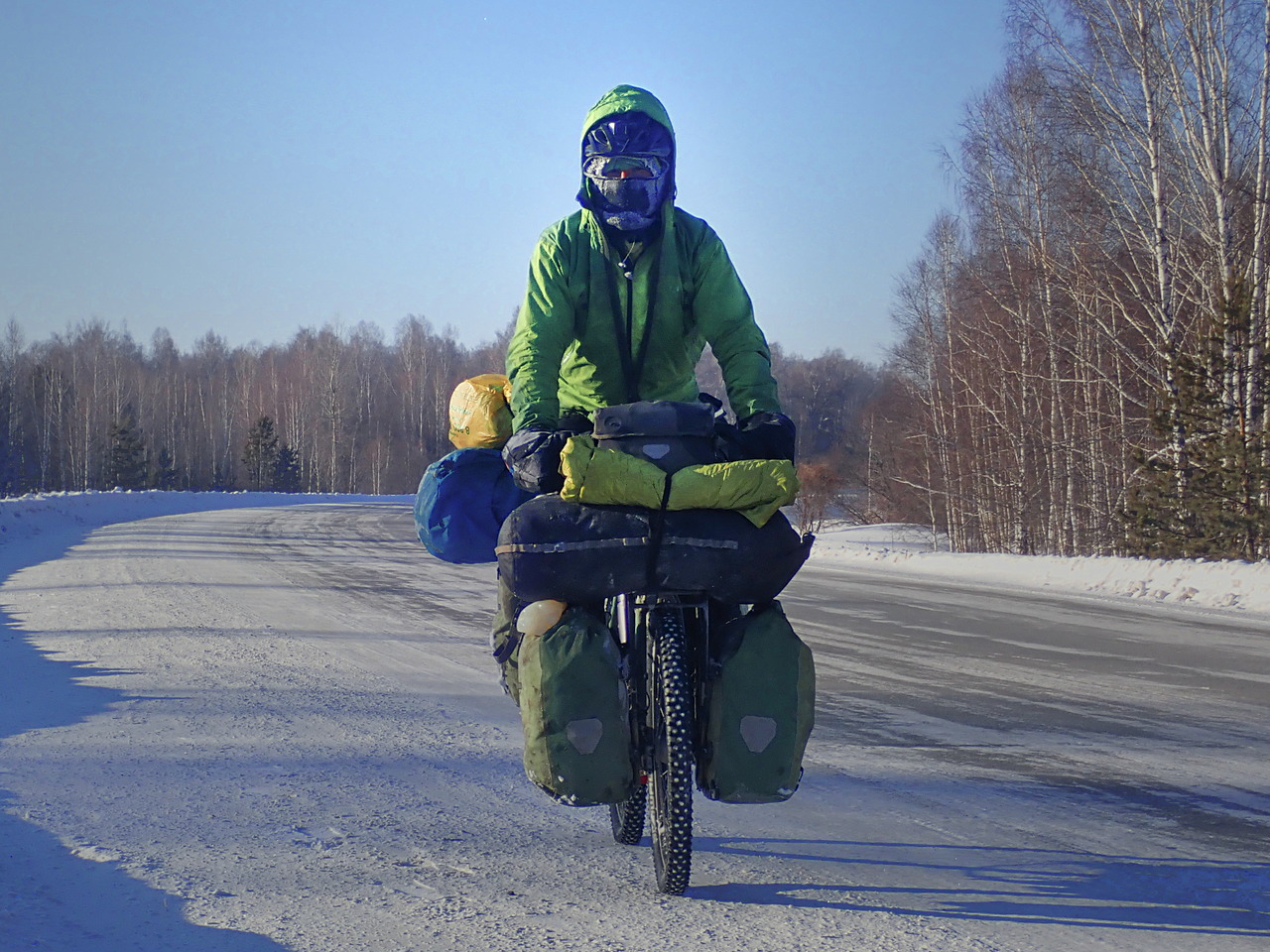
In winter 2018/2019, I cycled from Kazakhstan to Siberia, where the temperatures plunged below minus 40 degrees.
After my first travel through Eurasia, I had the possibility to work as a substitute teacher. I decided to use this extra income for a winter trip – cycling all the way to the frozen Lake Baikal in Siberia in Winter. The plan was rather simple: Leaving Switzerland on 1st November 2017, entering Russia in December 2017, arriving at Lake Baikal in February 2018 and crossing the frozen lake in March 2018. When I wanted to apply for a one year (business) visa for Russia, I found out that I may not stay in the Russian Federation on a multi-entry standard business visa for more than 90 days in any 180-day period. What a bummer!
Luckily I could keep on working as a teacher. So I continued earning money and decided to go to Siberia one year later, entering from Asia instead of Europe in order to be able to cycle a bit in Siberia and cross Lake Baikal within 90 days.
(Not) Getting the Russian Visa
In November 2018, I wanted to apply for a Russian business visa in Kyrgyzstan. I organized all the documents I needed to apply for a visa, but then I had to find out that foreigners like me aren’t allowed to apply for a Russian visa in Kyrgyzstan. I cycled to Kazakhstan, where Swiss people can stay visa-free for one month.
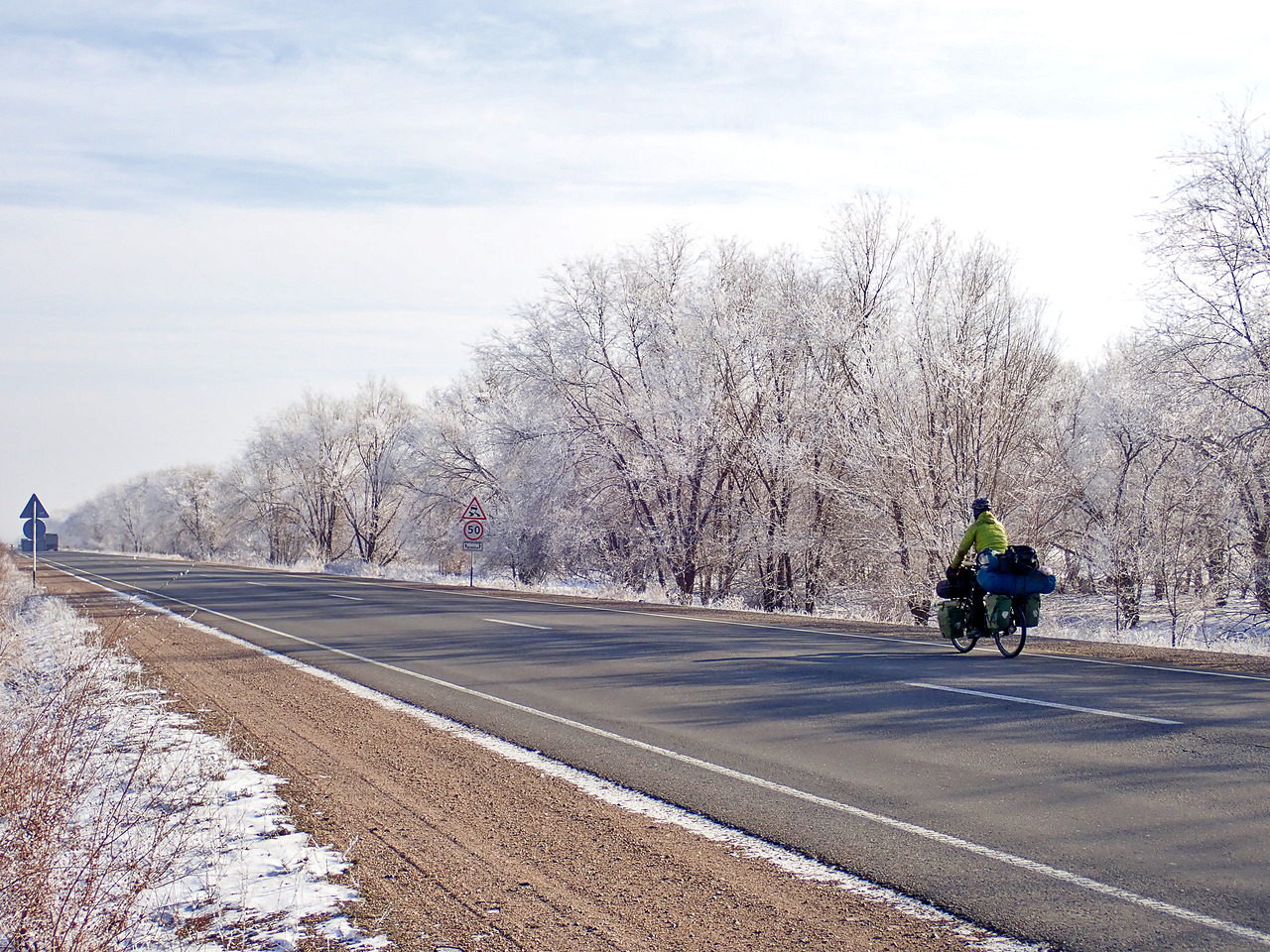
Almaty was my first big town in Kazakhstan. I went to the DHL office to send my passport back home to a Swiss visa service. I was shocked when I had to pay 120$ to send my passport back home – but I didn’t have any other choice when I wanted to be able to visit Siberia in winter. My plan was to cross Kazakhstan in the east from south to north without my passport and to pick up my passport with the Russian visa just before Christmas in Semey in the northeast of the country.
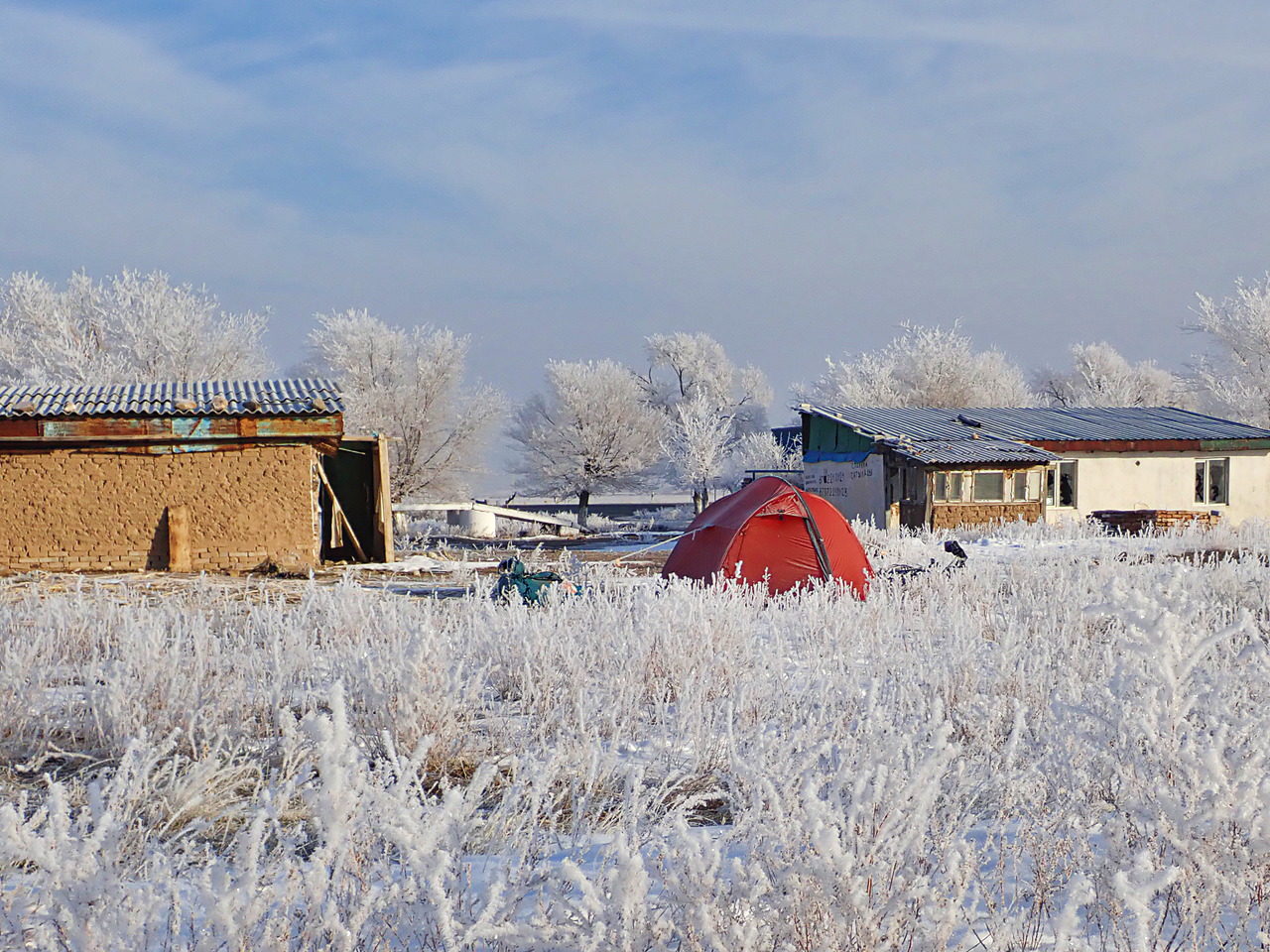
Boring Cycling in Kazakhstan
Cycling in Kazakhstan was relatively boring. It was not very cold at the beginning of December and there was not much snow around. One evening, it even started raining when I was pitching my tent. The rain later turned into snow and my wet tent froze overnight. When I went back on the road the next morning, I couldn’t cycle on the asphalt because there was a thin layer of plain ice on top, so I cycled next to the road. It didn’t take long until I saw a Lada (Russian car), that had overtaken me a bit earlier, lying on its roof next to the road. Luckily there were already some other people around and apparently, the driver wasn’t injured. Later that day, the weather got a bit warmer, the ice on the road melted and I could travel on the road again.
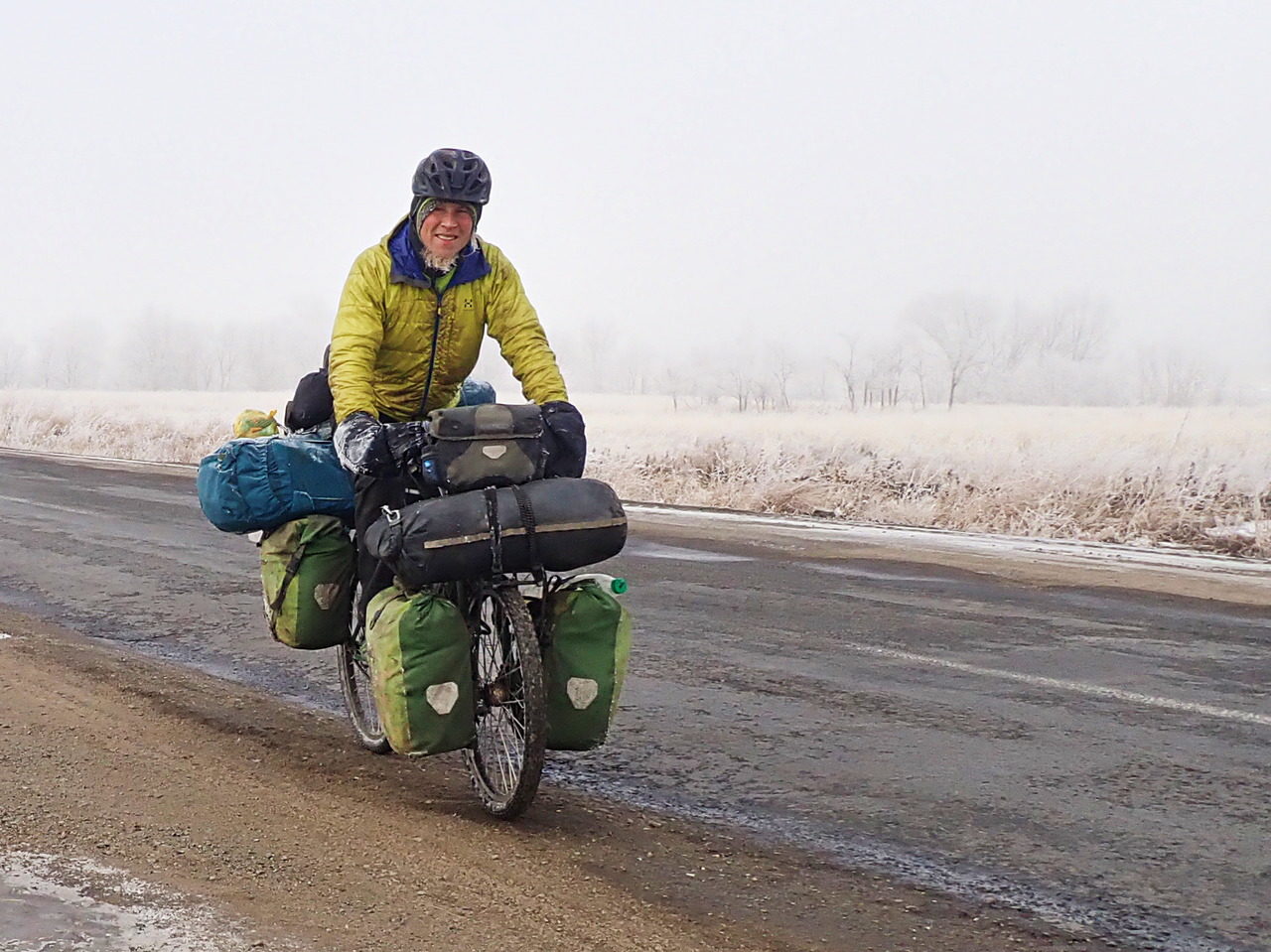
One evening it started snowing and it took me some time until I found a spot where I could leave the road and pitch my tent. It was snowing a lot overnight and the next morning, it took me quite a while to get back on the road. But there was too much snow on the road to cycle. I had no other choice than pushing my bike for one hour to the next petrol station. Close to the petrol station, there was a café. In front of that café, I removed my summer tires and I put my winter tires with spikes on. When I was back on the road, I was surprised how much grip these tires had. When I had been cycling in northern Russia and Scandinavia in March 2017, I fell off my bike several times. That would never have happened if I had used proper winter tires like the Ice Spiker Pro from Schwalbe.
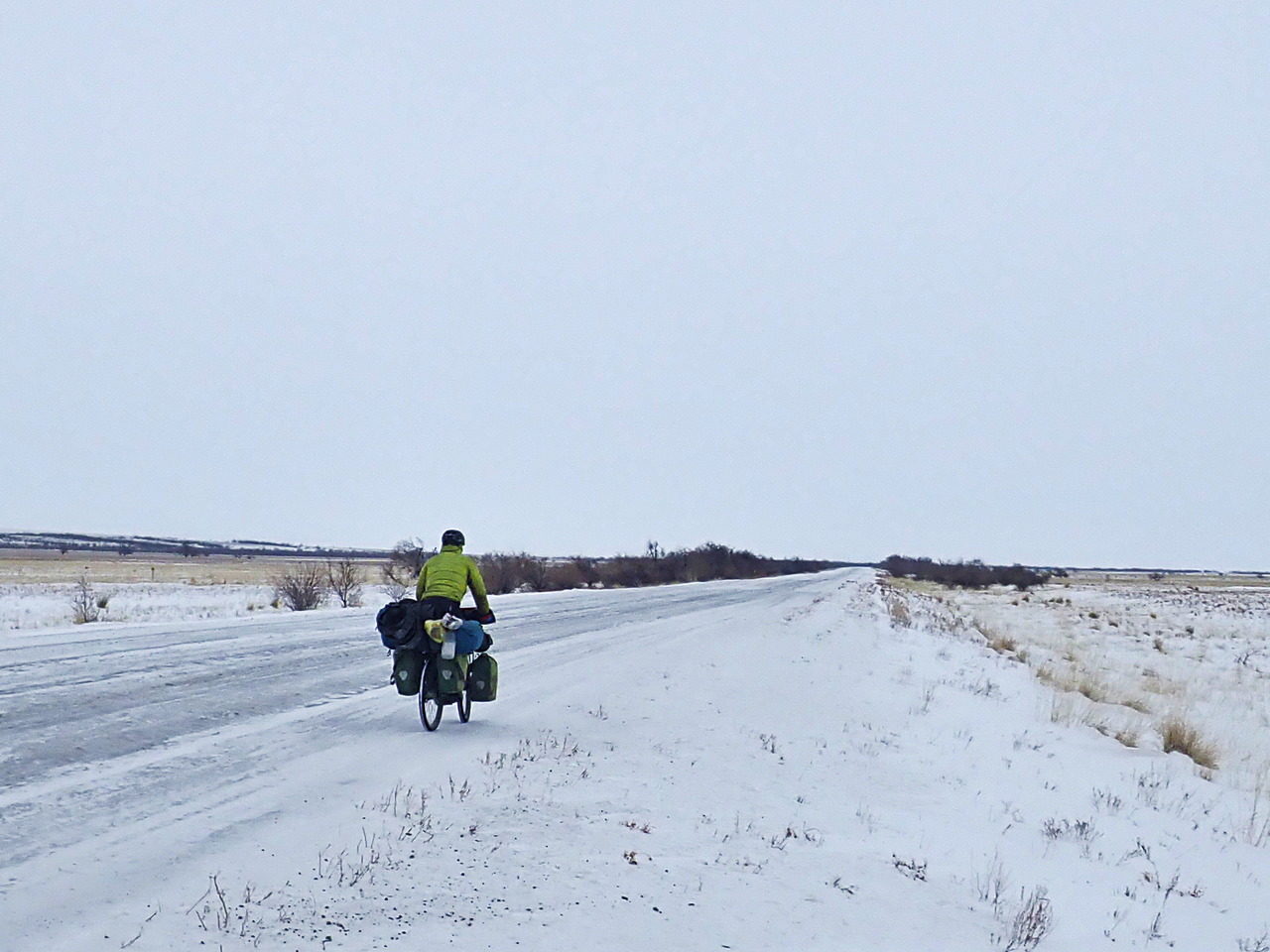
First Cold Front
The days started to get colder and colder. When I reached the town of Ayagoz, I went to a small shop in the evening to buy some food. I knew that the temperature would reach -28 degrees the next morning. When the locals told me, that the temperature will plunge to -38, I was confused. I checked on my phone again and the weather forecast was saying 28. The locals insisted that my information is wrong. I pitched my tent a few hundred meters away from the shop and combined two of my sleeping bags. Like that, I could comfortably sleep during the night. The next morning my thermometer showed a temperature between -25 and -30, so once more the forecast was right and the locals wrong.
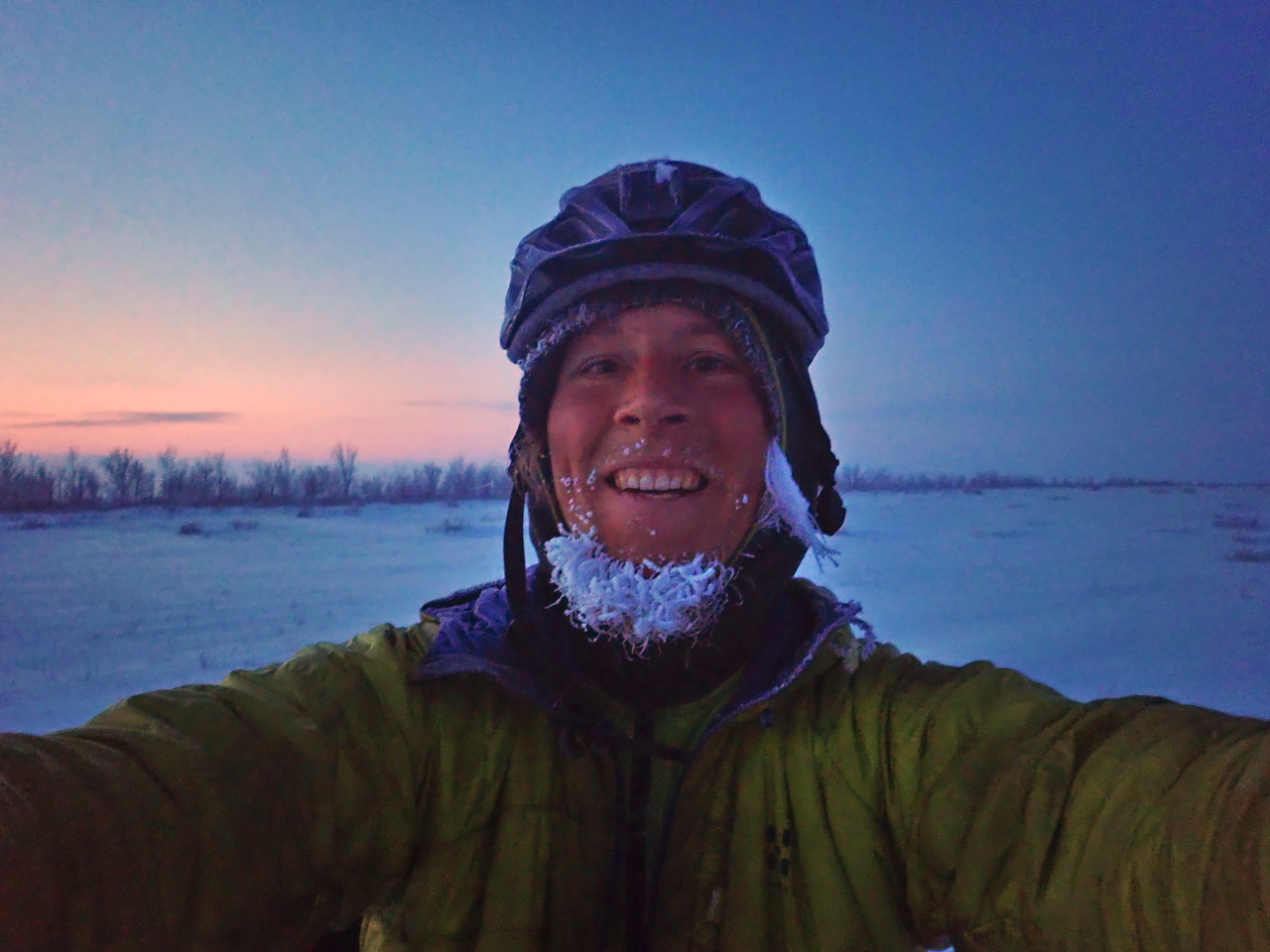
In the beginning, cycling at -25 was much more difficult than sleeping. One of the main reasons was the strong headwind, which forced me to use my balaclava with the face mask. The other difficulty was the lunch break. Because of the strong wind, I started to feel cold very quickly. I removed my face mask because I obviously couldn’t eat otherwise. But because of the cold temperature, the wet mask froze instantly and after eating I had to put a frozen mask on. I needed to cycle around fifteen minutes before I felt warm again. The main problem was, that I had been sweating a bit while cycling and the moisture froze inside my jacket. Later in Siberia, I realized that it is much better to wear a windproof jacket (my old rain jacket in this case) instead of the thin insulated jacket.
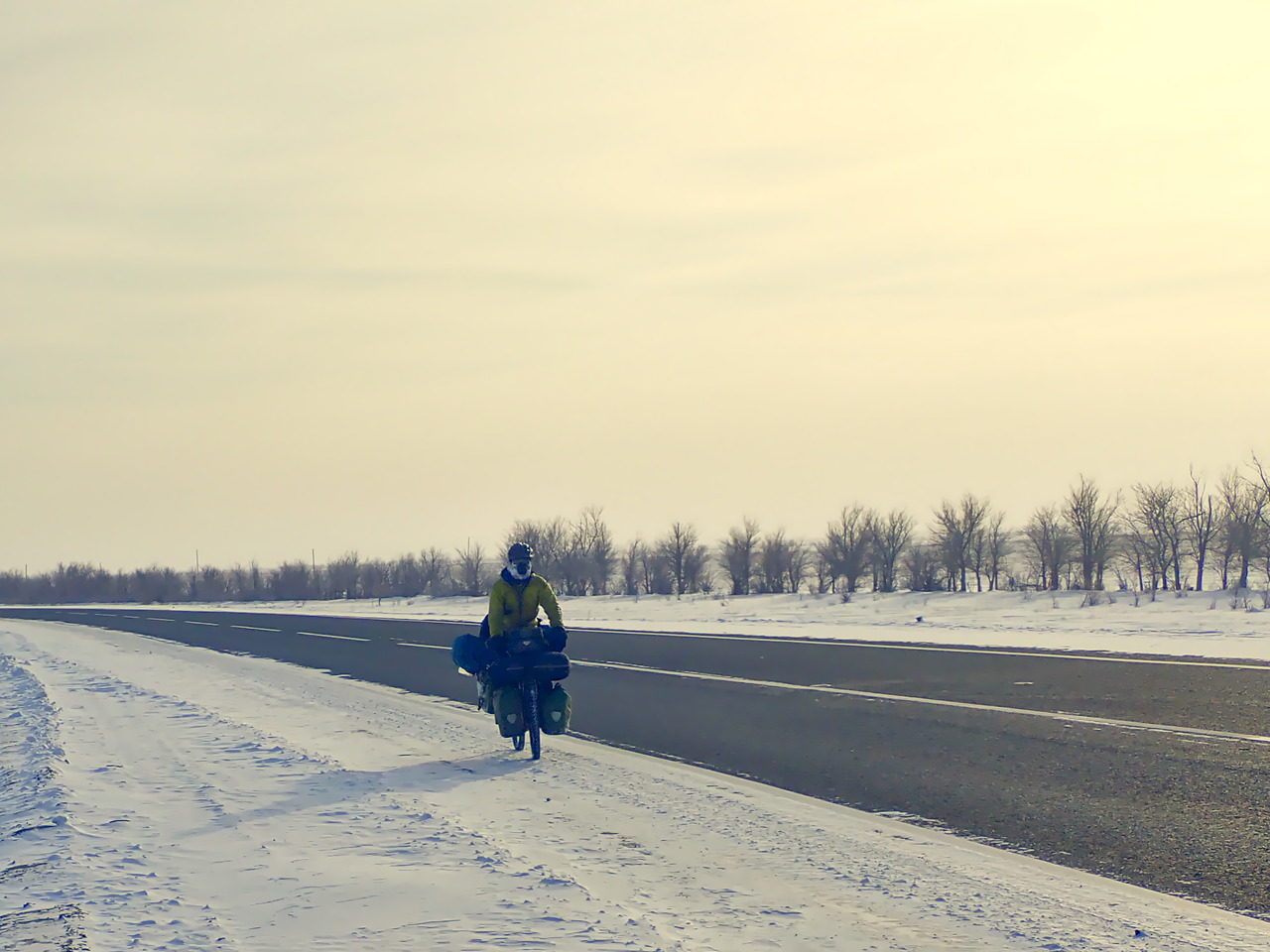
One evening I rode past a petrol station. The temperature was -28 degrees. I intended to pitch my tent soon, but as there was an intersection close to the petrol station, I wanted to continue a bit to be away from villages and people who could disturb my rest. A car followed me and the people wanted to talk to me. Unfortunately, I neither speak Russian nor Kazakh, and they didn’t know English. When I stopped to check with my headlamp if I could pitch my tent nearby, the two guys came out of their car and used google translator on their phone to “talk” to me. I could explain to them that I was about to camp there. The two young men couldn’t believe it and told me that I would “freeze to death” by doing so. I had checked the weather forecast before and I knew that the temperature wouldn’t fall much below -30. Nevertheless, the guys were scared that I wouldn’t survive the night and invited me to their home. I was very tired and hungry and I really wanted to camp – because I came to this area of the world at this time of the year to get exactly these kind of experiences. But I also knew that the risk was high that people would come to my tent all night long to check if I am still alive, which would mean very little sleep for me. Darkhan, the young guy, told me that he is living two kilometres away. I agreed to come with them. Unfortunately, the house was more than 5 kilometres away and it took me nearly one hour to get there. Darkhan was living together with his parents, his wife and his child in a house. They fed me with potatoes and pickles. After the meal, Darkhan invited me to a banya, a public steam bath. Although I had wanted to spend the night in my tent, It was also very interesting for me to get the banya experience with locals.
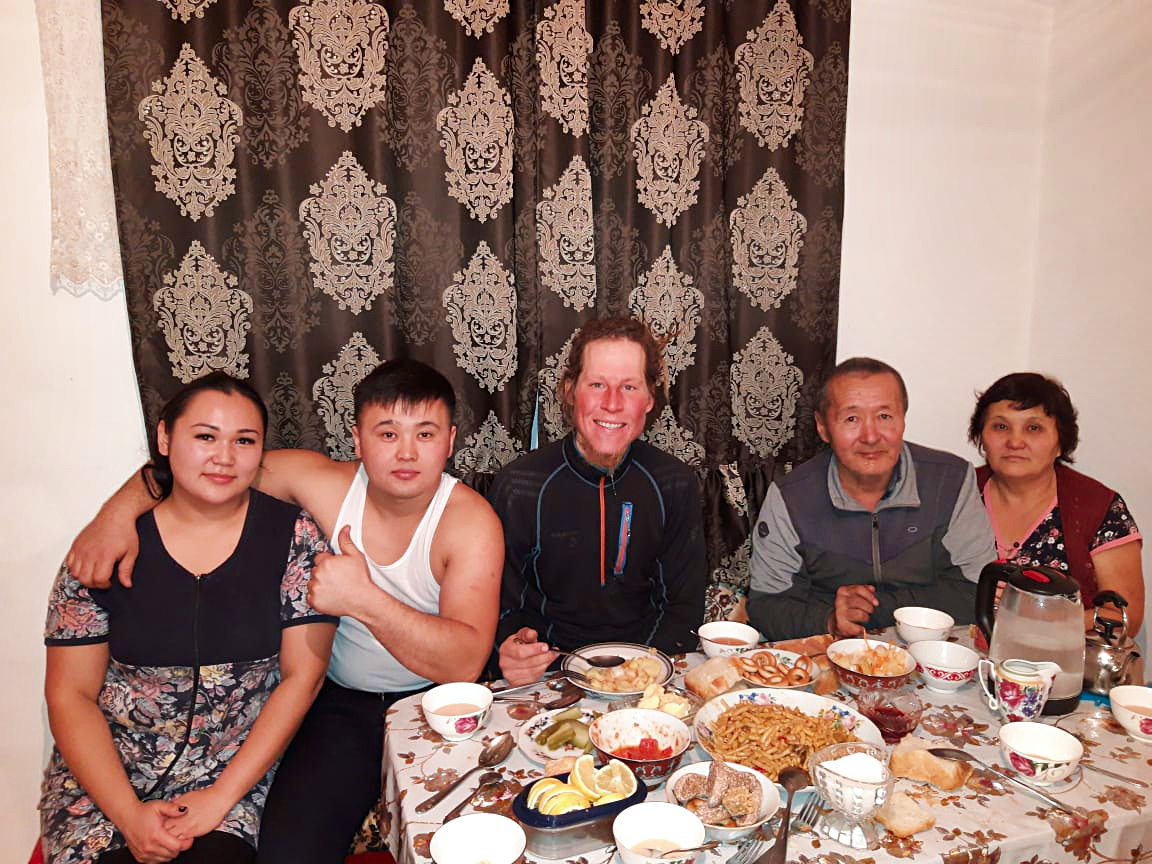
The next morning, the temperature was below -30 degrees. When I wanted to leave, I realized that I had a flat tire. Luckily I could go back inside the warm house and fix it there. Then, I was finally able to leave and cycle at -30 degrees.
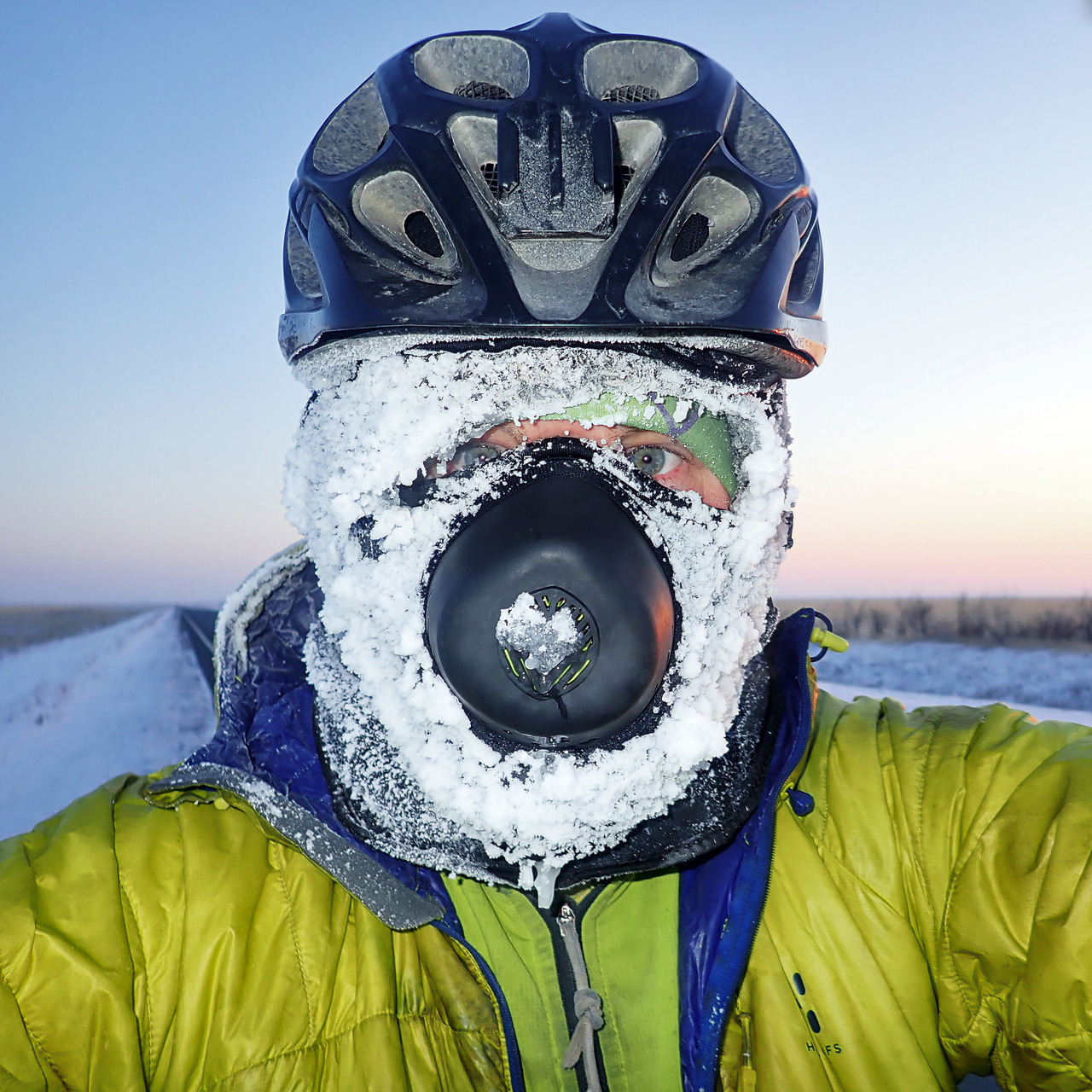
I already knew that I would arrive in the town of Semey the next day, but before I arrived there, I could spend a night in my tent below -30 degrees. I realized in the evening that I had been sweating too much again, so the moisture froze once more in my winter jacket. That’s when I decided that I really should fix the broken zipper on my old rain jacket when I am in Semey so that I don’t need to wear the thin insulated jacket while cycling. I was excited to spend my first night below -30 degrees in my tent. But when my stove didn’t work and I had to clean the jet in the cold, I realized how important it really is to have reliable equipment when the climate gets harsher. Luckily I managed to fix the issue and I could use the stove in the evening and also the next morning. I was surprised how comfortable it was to sleep under these conditions. Before leaving Switzerland, I had thought that -30 will be extremely cold and challenging, but with the right tent, sleeping bags, sleeping mat and clothes, it was much easier than expected.
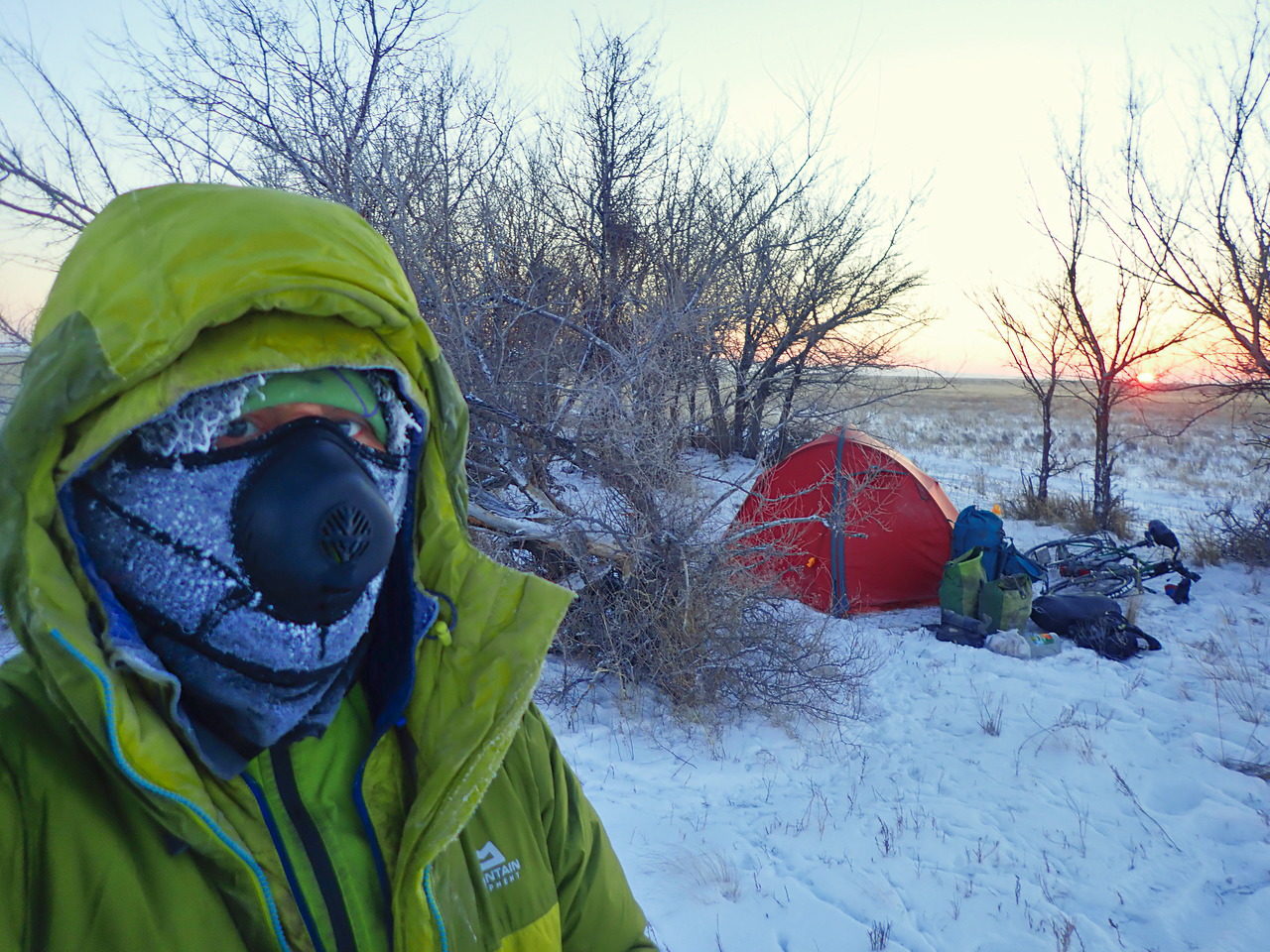
Going to Court in Kazakhstan
In Semey, I could stay with Yernar, a friend of another cyclist. Yernar is living in an apartment together with his mother Nadia. He is the owner of a café, where Nadia also prepares some food. I intended to stay a few days with them until I could pick up my passport at the DHL office in town.
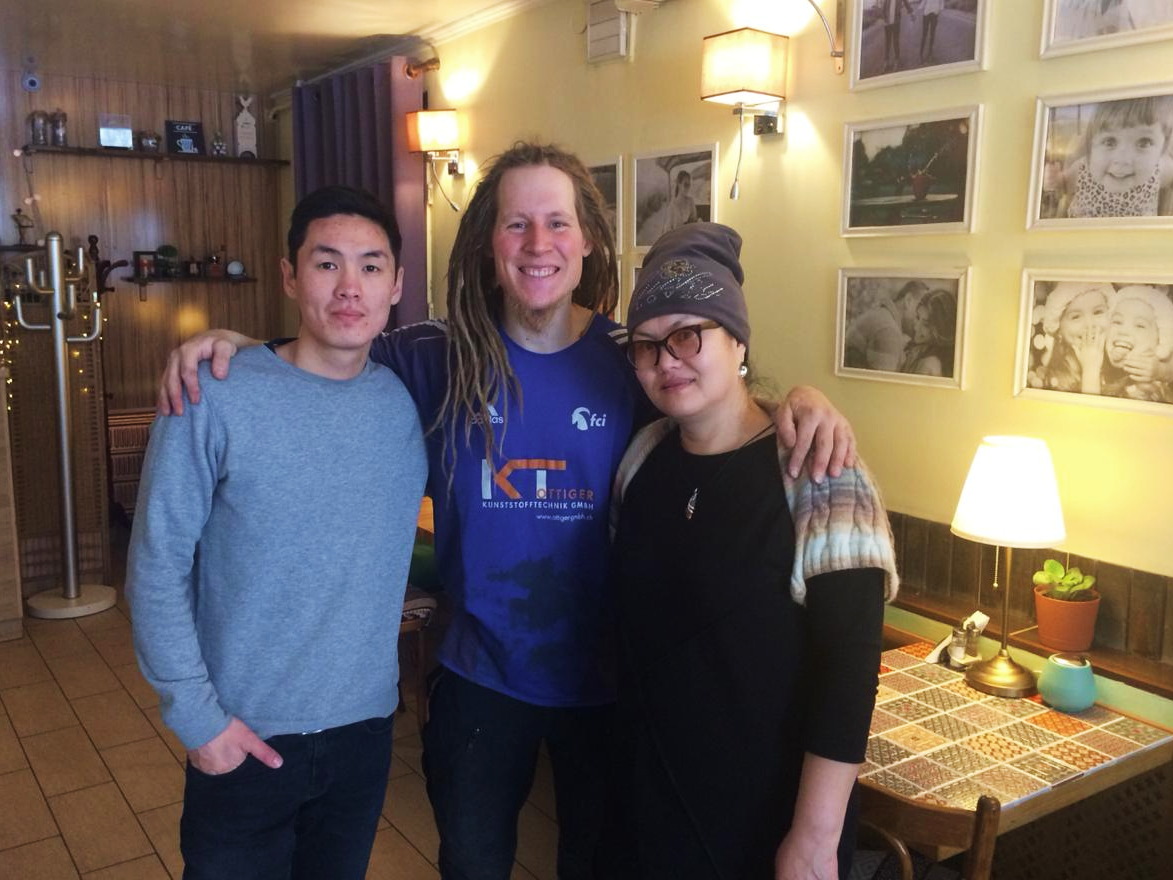
Unfortunately, the Russian embassy in Switzerland didn’t issue the visa on time. When I was supposed to leave Kazakhstan after one month, my passport was still at the Russian embassy in Switzerland. I went to the police station and I explained to them that I was about to run out of my 30 days but that I couldn’t leave Kazakhstan without my passport. They told me that they can’t help me as long as I don’t have my passport with me. A few days later, I was still waiting for my passport and now I was illegally in Kazakhstan. Luckily the times when tourists had to pay a 5’000$ fine for overstaying were over! Because of Christmas and New Year, the passport arrived more than two weeks later than promised by the Swiss visa service. Luckily I could stay all the time at Yernar’s place and could eat delicious vegan food in the café.
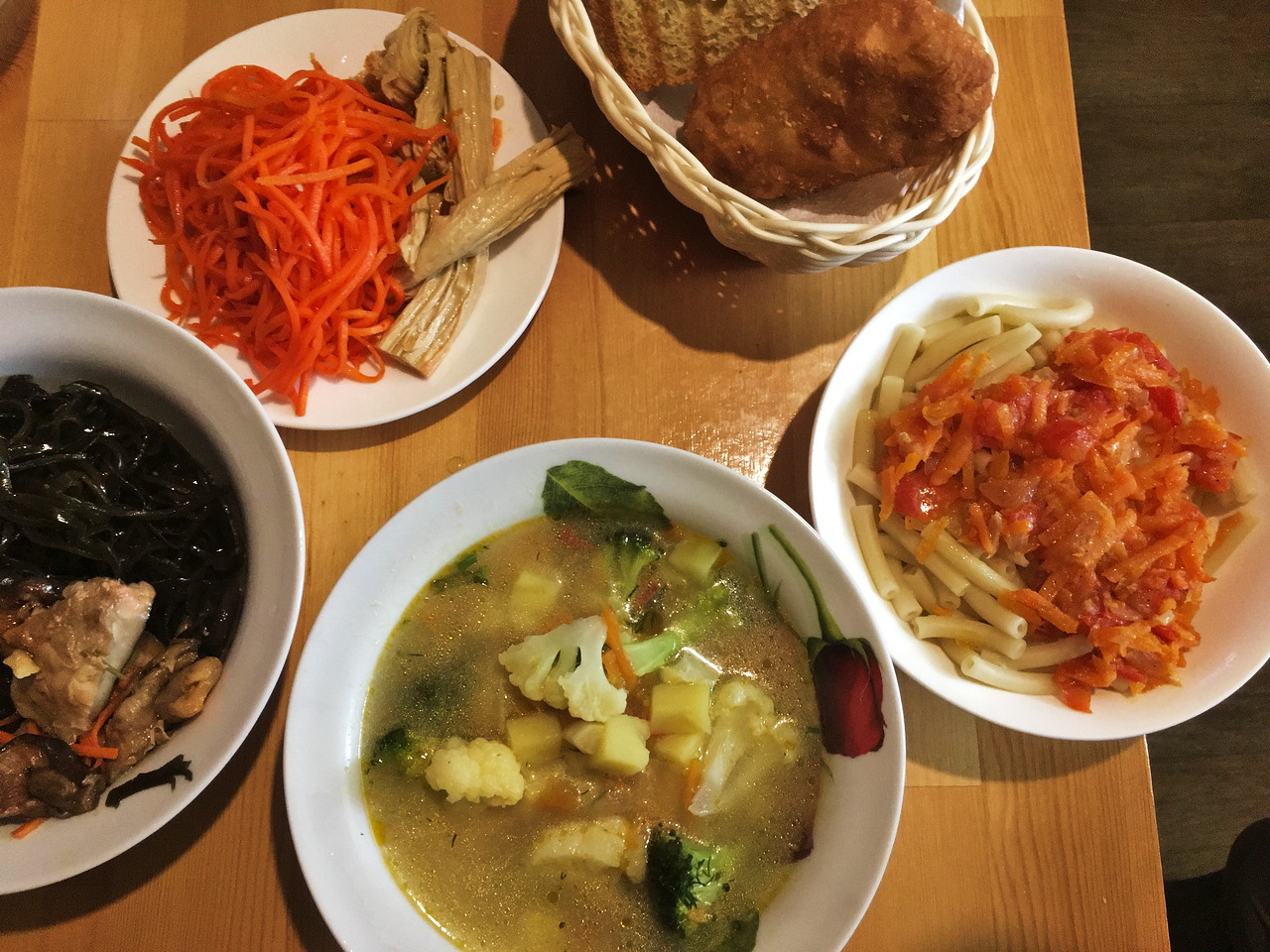
When I finally got my passport back, I went to the police again together with Yernar. They told us that I have to bring a certified translator with me. Yernar helped me once more and found a translator who could translate from Russian to German and vice versa. Nikolai, the translator, decided to work for me for free! We went back to the police station, filled in some forms and then we had to go to court one day later. In court, I was sentenced to a fine of 70$. The funniest thing happened straight after the trial: The prosecutor asked me for my Instagram so that she can follow my travels.
After the trial, I needed to apply for an exit visa in order to leave the country legally. Unfortunately, I couldn’t obtain this exit visa in Semey and so I had to travel 200 kilometres to Oskemen, also known as Ust-Kamenogorsk. Yernar joined me and helped me once more to deal with the bureaucracy. After more than three weeks with Yernar and Nadia, I could finally continue travelling by bicycle.
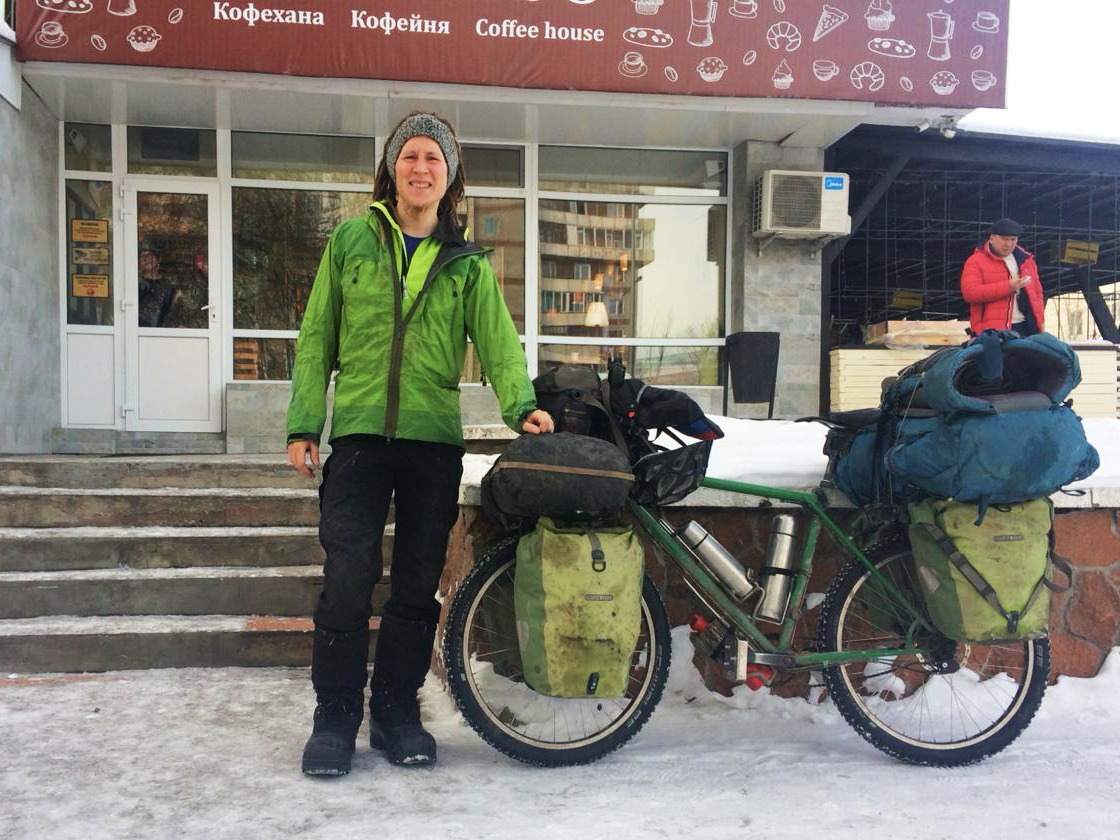
When I left Semey on 20th January 2019, the temperature was only a few degrees below zero. The first night in my tent in 2019 was unpleasant. Usually, I love to sleep in my tent. But my stove from Primus was not working at all. As I was aware that a working stove can be very important in winter, I had bought a complete spare stove in Switzerland. But the spare stove didn’t work either! No matter how I combined the pumps with the fuel lines and the stoves, it was not working. Luckily it was not very cold and I still had some hot water in my thermos bottles. I added fresh snow to the hot water to multiply the amount of drinking water for the evening, night and morning.
Warm Front in Siberia
The next day, I crossed from Kazakhstan into Russia. I didn’t mind the warm weather because it made the border crossing much more pleasant. As it stayed relatively warm, I decided to spend one more night in my tent without a working stove and try to fix the problem properly in the Russian town of Rubtsovsk. In Rubtsovsk, I found a garage with very helpful people. We cleaned the clogged stove the whole afternoon and made sure that all the possible combinations of pumps, fuel lines and stoves were compatible. Interestingly, I had to change the original O-ring on one fuel line because otherwise, it wasn’t working with one of the pumps. That should obviously not be necessary, but somehow it was the only way how to get this fuel line compatible with both pumps.
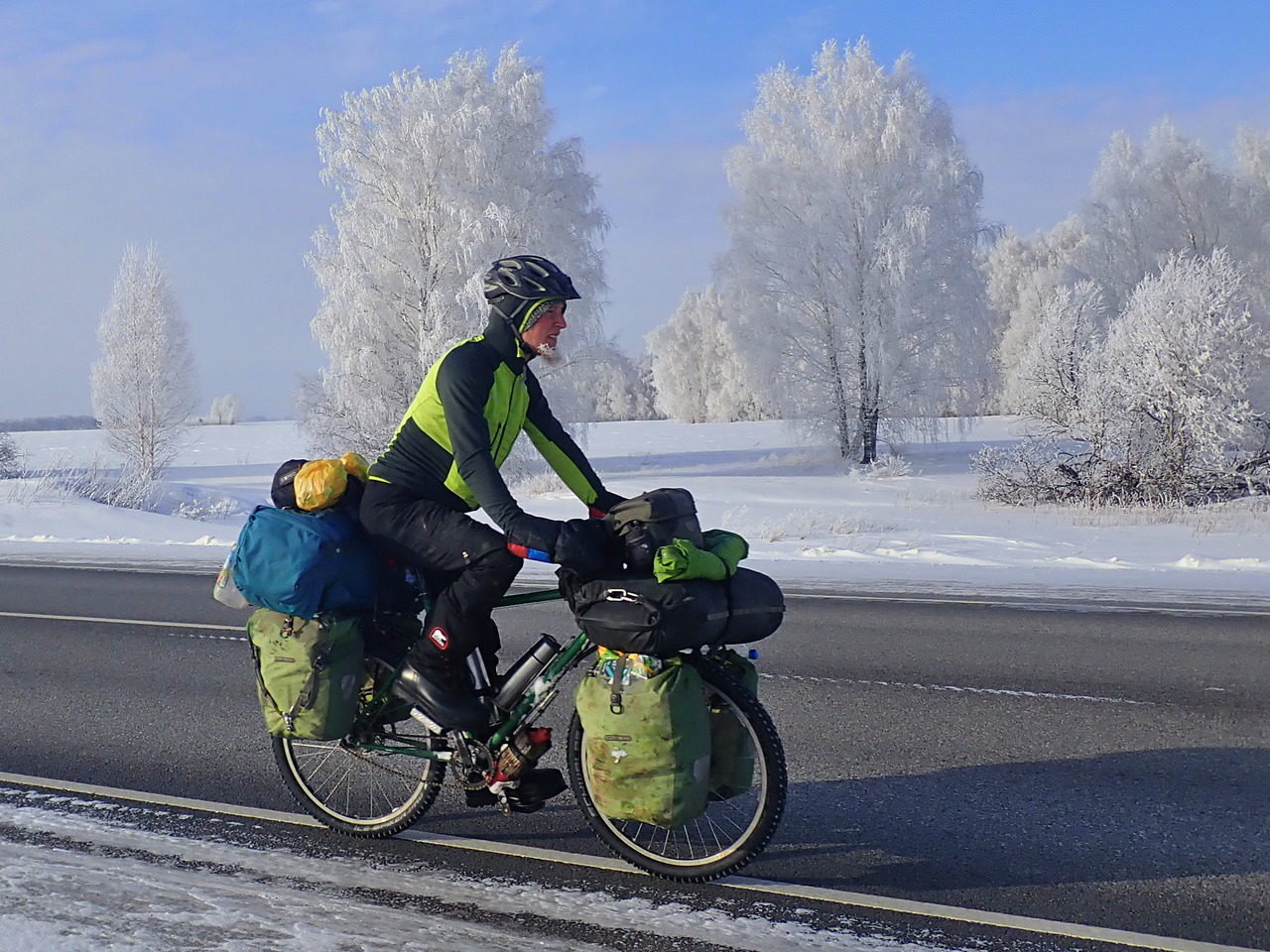
On my way to the Barnaul, I was camping next to the main road. One morning, a man came to my tent and started to talk in Russian to me. I asked him if he speaks English. He denied, but he knew German, which was great as well. Juri, that’s his name, told me that he knows Peter Eichenberger from Switzerland. I don’t know Peter in person, but I know his name because I saw some of his pictures on the website of the Swiss outdoor company Exped. Juri told me that he lives in Barnaul and that I could stay with him there. A few days later I arrived in Barnaul, stayed with Juri and we had a great and very entertaining time. He had done some crazy white water rafting when he was younger and the pictures that he showed me looked very scary to me. In the evening, a friend of Juri came to his apartment. His daughter was living in Krasnoyarsk, a big town on my way to Lake Baikal, and I got the offer to stay with her when I arrive there.
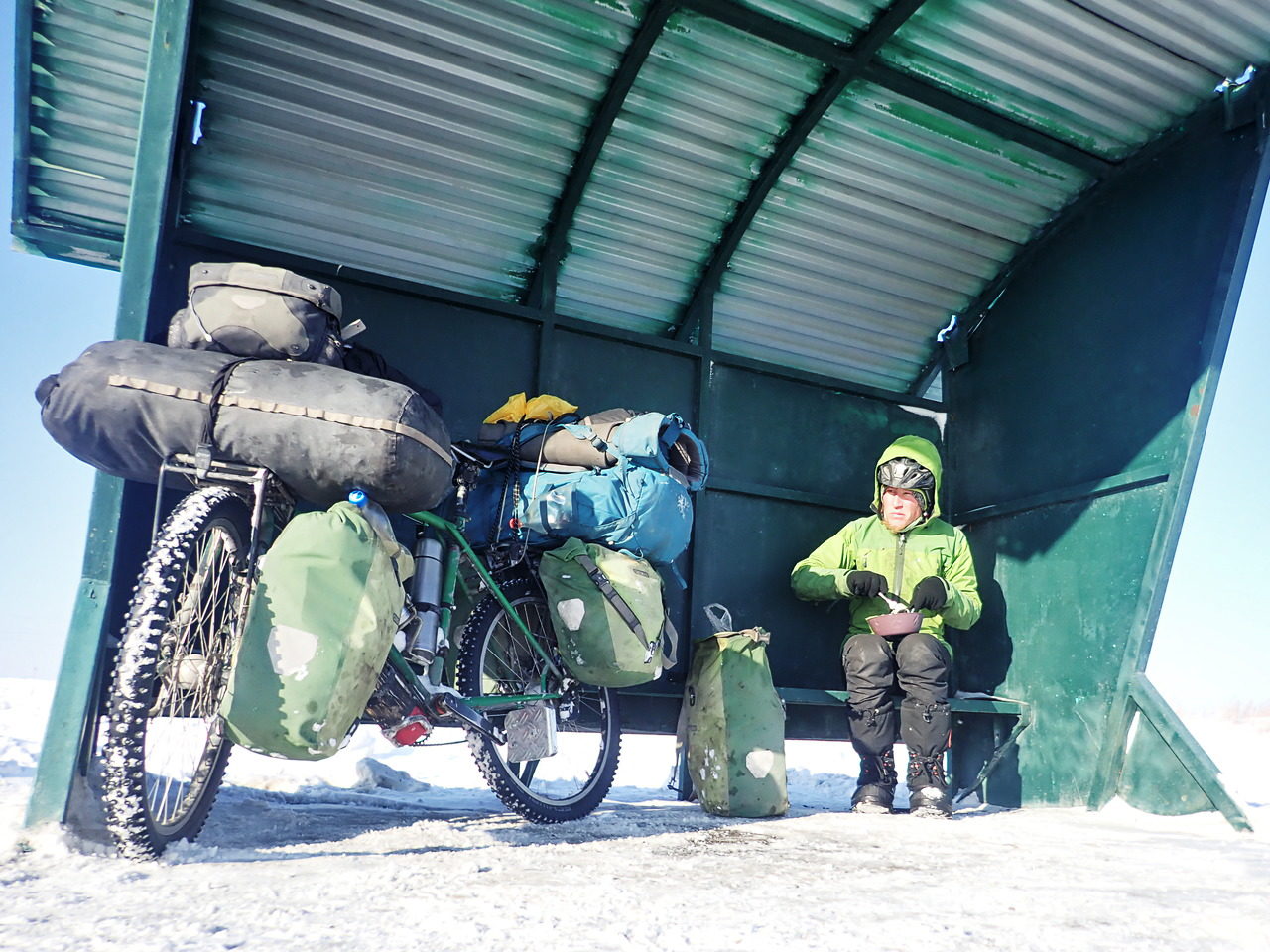
I didn’t want to travel from Barnaul to Novosibirsk, so I decided to go to Kemerovo. But I also didn’t want to cycle on big roads. Fortunately, I found some smaller roads that I could use. The roads were mostly covered in snow, which I really liked because I was already sick of cycling on dusty paved roads. There was very little traffic on these small roads and I could enjoy my lonely days in the winter wonderland. Sometimes the night temperature fell below -25 degrees again. I had fixed the zippers on my old rain jacket in Semey, so I wasn’t wearing my thin insulated jacket anymore during the days. Therefore, this jacket wasn’t partially frozen in the evenings and thus my warmest sleeping bag alone was usually warm enough in combination with my dry thin insulated jacket. But sometimes, I woke up in the middle of the night and felt a bit cold. In these cases, I just ate some nuts, waffles, or chocolate and drunk a few cups of extremely sweet tea. Like that, my body got more calories and could keep on heating.
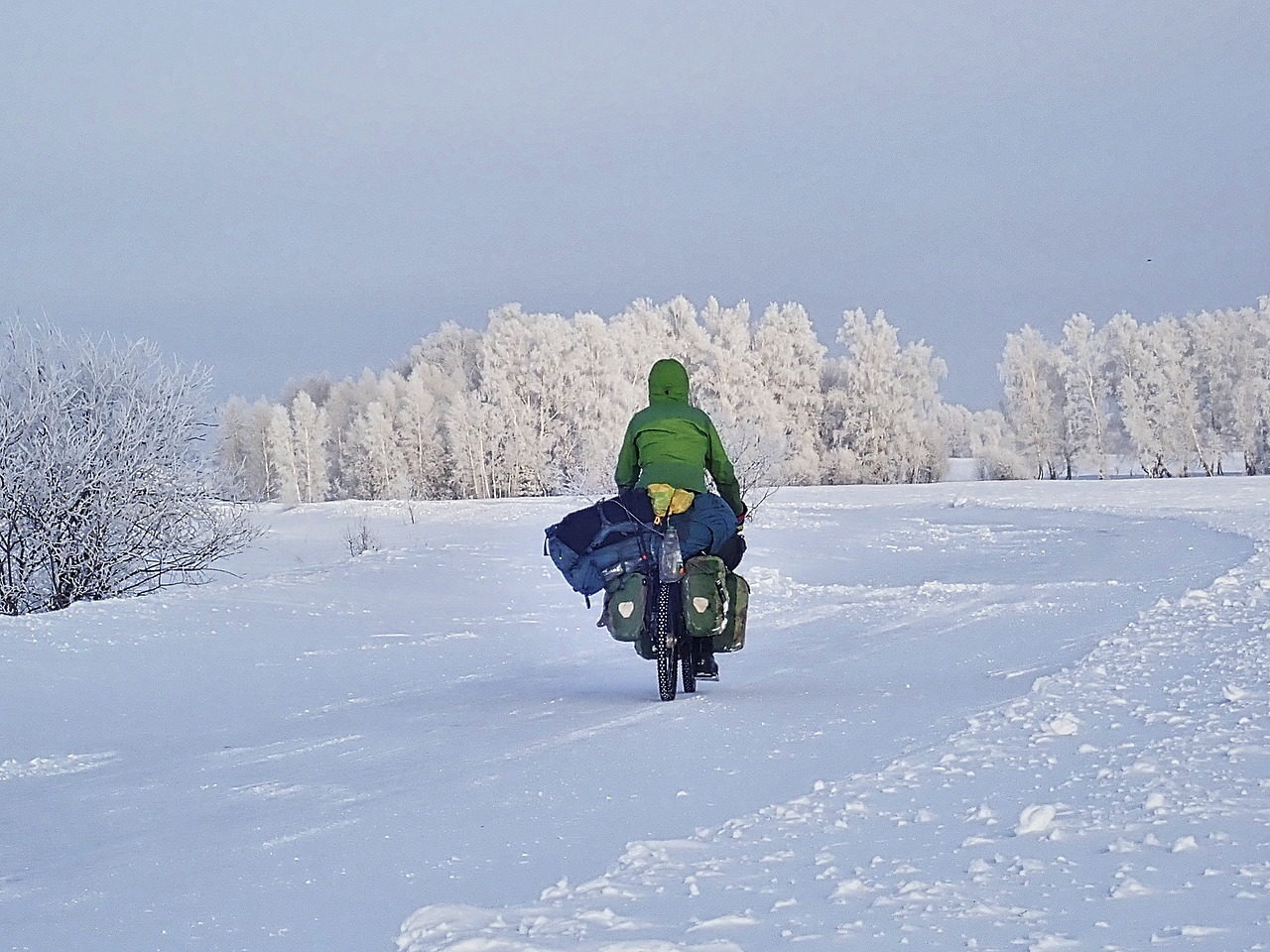
The Winter Came Back
Unfortunately, I couldn’t continue forever on these roads and so I had to travel on busier roads again. The temperatures plunged below -30 again, but I had learned my lessons and I wasn’t wearing too many clothes anymore, so I managed to avoid sweating and thus moisture wasn’t a big issue anymore. Another lesson I learned was how to keep my feet warm: I had bought extremely warm shoes in Switzerland. These boots are rated to -70 degrees and are around 3 kg heavy. That sounds extremely warm, and they are. Unless you start sweating because then the moisture will be somewhere in the shoe and will freeze overnight. Even when you take the inner shoe out and dry it completely in the sleeping bag overnight, there will also be moisture in the outer shoe and this moisture will be frozen in the morning, thus you will put your feet in a warm and dry inner shoe, but this inner shoe will be in a frozen outer shoe and thus the feet will get cold and stay cold during the day. Therefore it’s important to avoid any kind of moisture in the shoes. That’s why I started wearing only very thin socks and thin plastic bags on top of them. So when I was sweating, the socks would get a bit wet but the plastic bags kept the moisture away from the shoes. In the evenings, I removed the plastic bags and dried my socks above my stove for a few minutes. Of course, I couldn’t get all the moisture out of the socks so quickly, but at least they were more or less dry and my feet could easily dry inside the sleeping bag, although the moisture gets inside the sleeping bag like that.
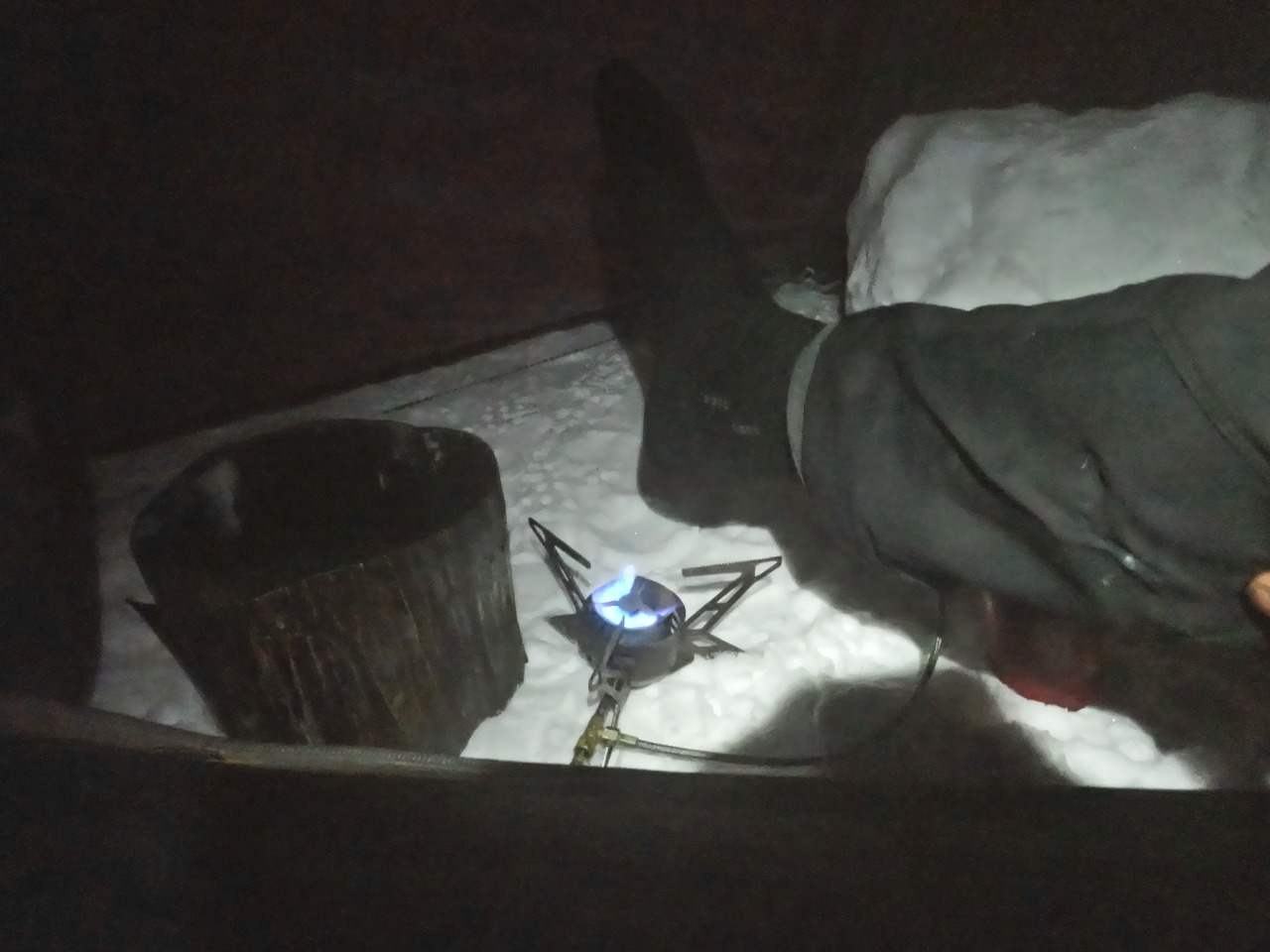
I really liked and still like travelling in the cold, but there are also some disadvantages. The most difficult thing for me was to eat something during the day. Cooking breakfast or dinner in the tent is very comfortable because there is no wind and the heat from the stove also warms the tent to comfy -20 degrees. But when I stopped during the day to eat some sweets, I couldn’t stop for too long because otherwise, I would start to feel cold. I also couldn’t remove my thin gloves because I would risk getting cold fingers otherwise, and maybe even getting frostbite. When the temperatures are above freezing, I usually cook too much breakfast so that I can eat the leftovers for lunch. That obviously doesn’t work in colder temperatures as the food will probably already be frozen by the time you packed your tent.
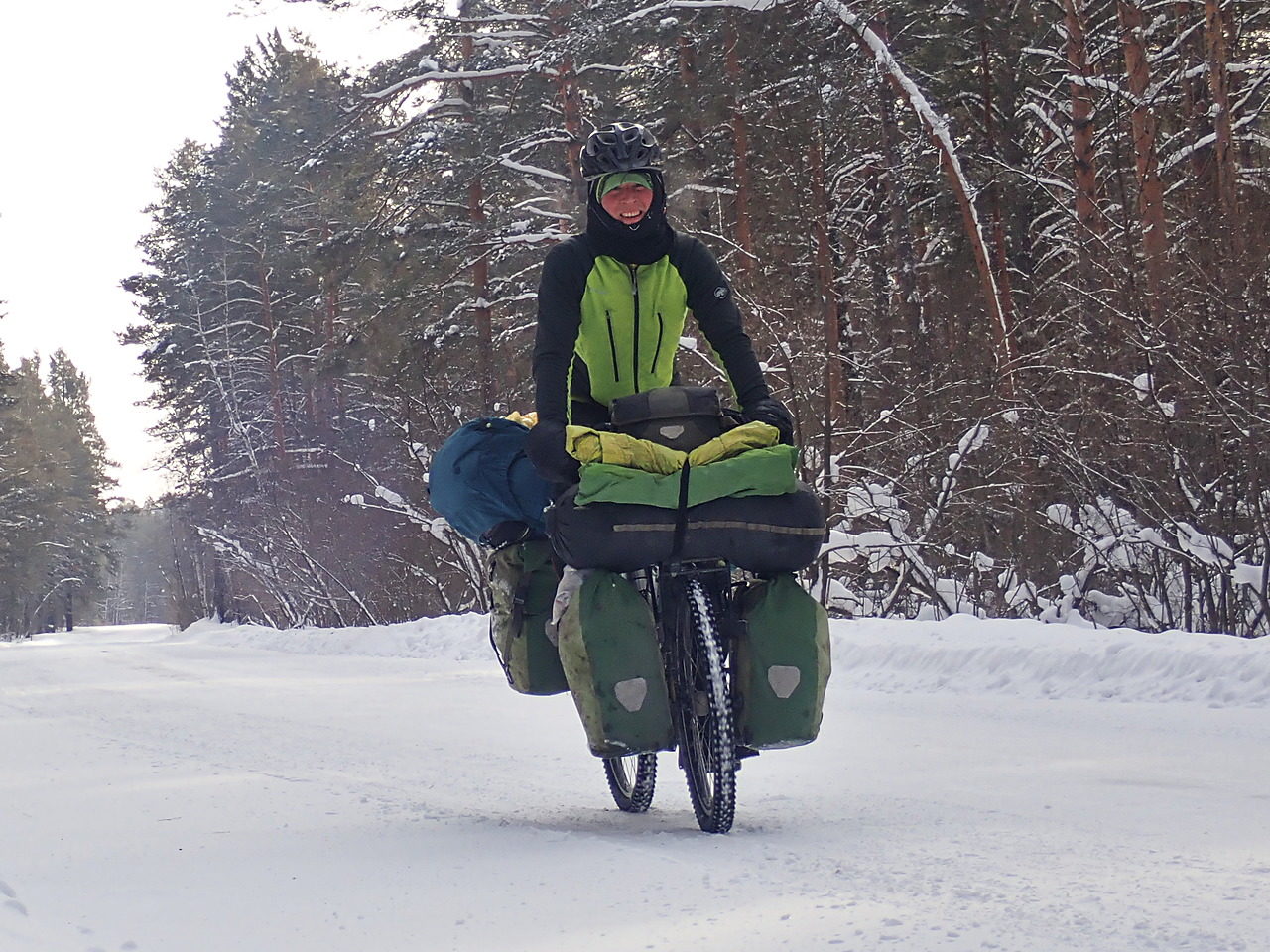
Cold Days
One day on my way to Belovo, the thermometer still showed -35 degrees when I started cycling. When I made a short break to eat some sweets, a car stopped and the two men from the car wanted to talk to me, but unfortunately, they only spoke Russian. Nevertheless, they could explain to me that it will be very cold next night. When I told them that it is no problem, they wanted to make sure that I understood what they tried to explain to me, so they wrote “47°” in the snow next to the road. Obviously, they meant minus 47 degrees, but in winter in Siberia, nobody mentions the minus when talking about temperatures. And moreover, the locals are usually talking about the windchill or “feels like” temperature, which doesn’t really matter inside a tent.
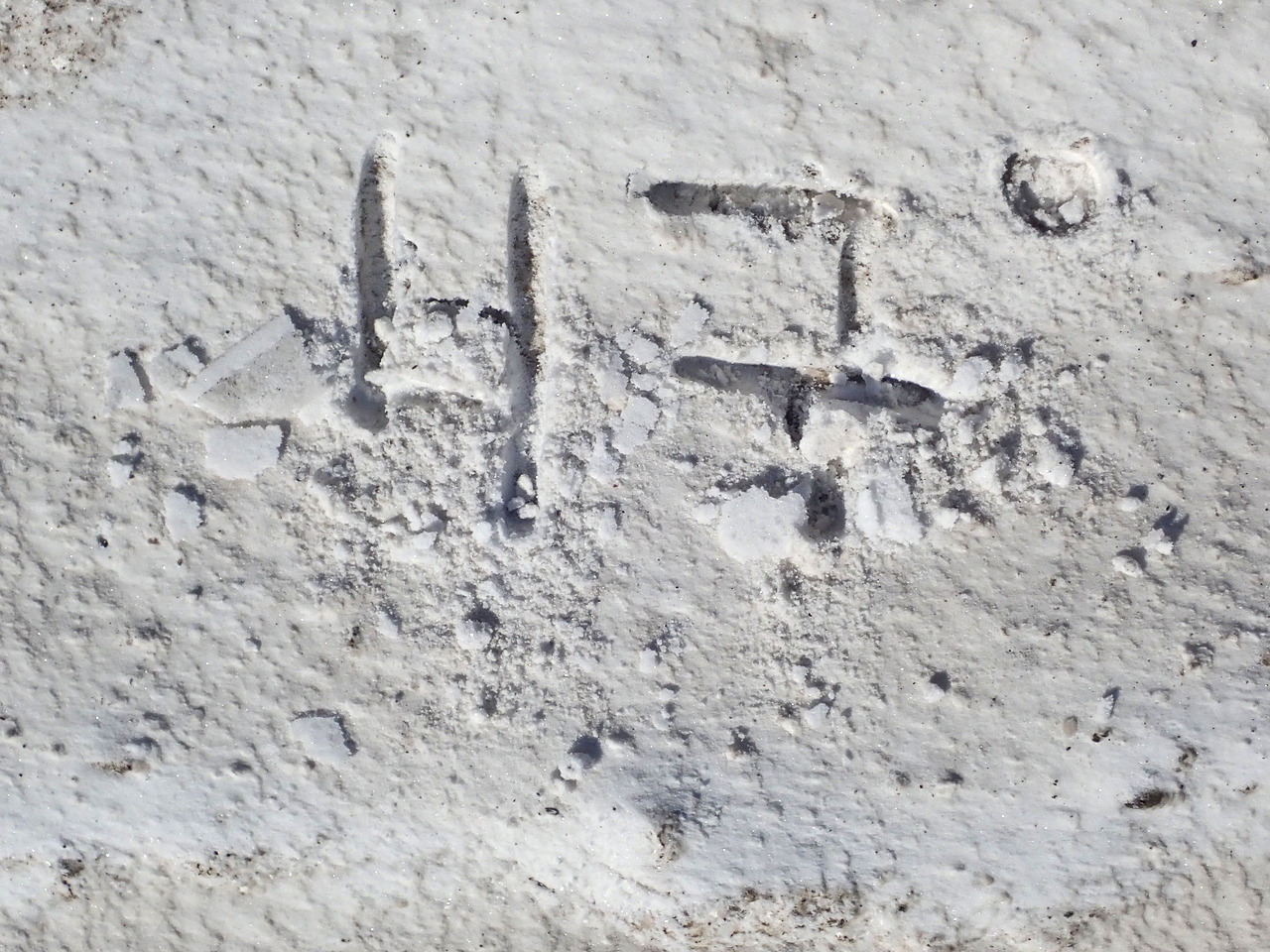
During the day, the temperature stayed below -30 and it got noticeably colder in the late afternoon and I started to get cold fingertips. Getting cold fingers is not a big deal when the temperature is above -20, but when the temperature gets close to -40, I had to make sure that there was enough blood circulating in my fingers, otherwise, my fingers could get frostbitten. I moved my fingers for two minutes, but it didn’t help, so I started to swing my arms and I had the feeling that more blood was going through my hands. But there was also another reason for my cold fingertips: I was wearing my thin gloves all the time while cycling and apparently, I started to sweat a little bit. The moisture on the tips of the gloves was frozen and thus it got more difficult for my fingers to keep warm.
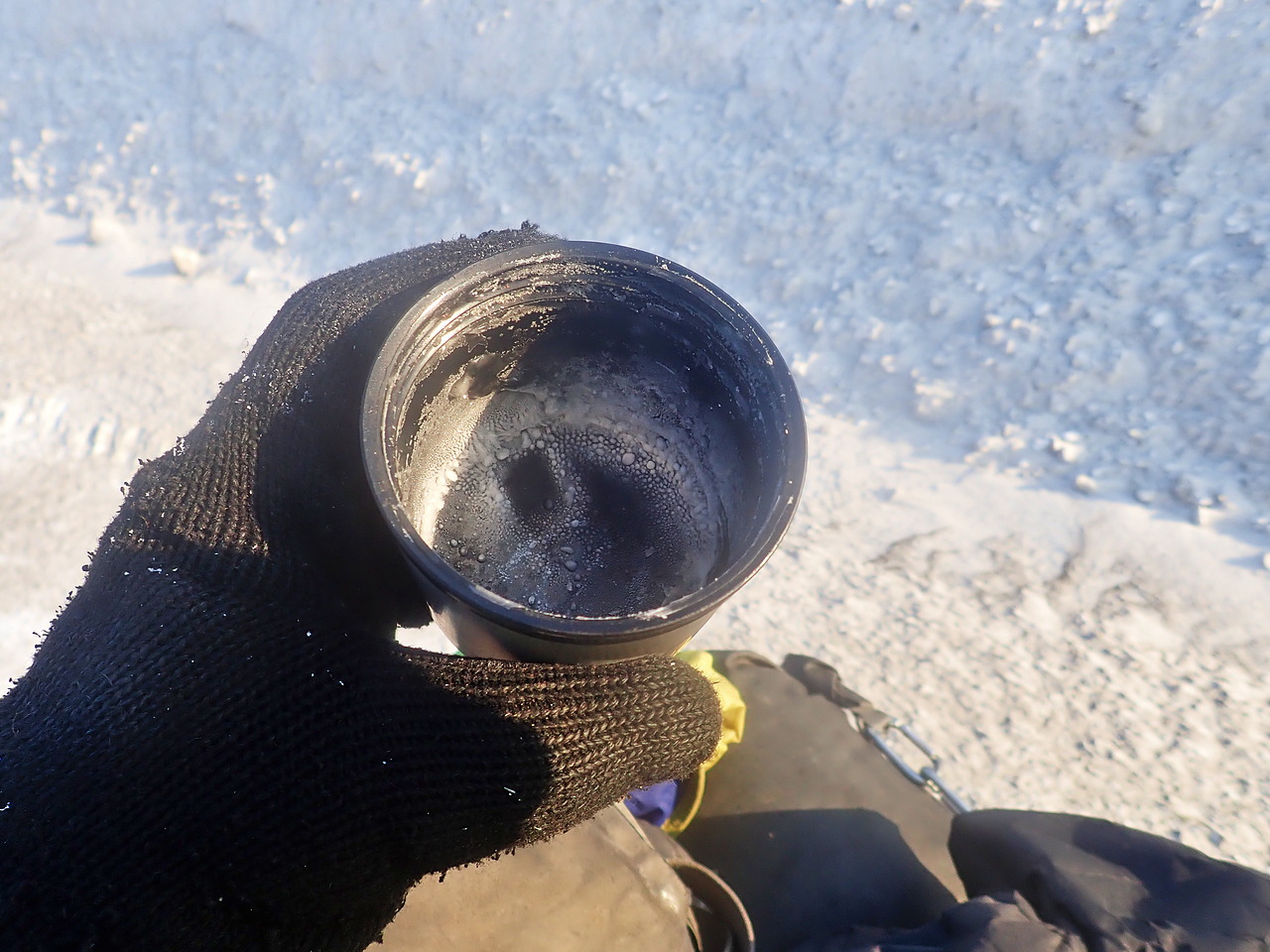
In the evening, it got colder and colder. I was already looking for a good spot for the night, but unfortunately, I got a flat tire. When I checked the temperature, I estimated that it must be -40 degrees. I couldn’t see a good camping spot, so my plan was to inflate the tire, continue until I’d see a suitable spot to pitch my tent and repair the tube the next morning inside my tent with a burning stove nearby. Unfortunately, my pump didn’t work at all in the cold, so I had to find a place nearby to pitch my tent. I couldn’t see a good spot, so I just walked a dozen metres through deep snow and decided to pitch my tent there. But first I had to remove or compress the snow to get a good area to pitch my tent. This kind of work is very annoying and could be partially avoided on better camping spots, but this time I just couldn’t continue and had to deal with the situation. I managed to pitch my tent properly and luckily my stove was working, so I could prepare my dinner. It was a cold evening and I knew that it was going to be a tough night, but I was also sure that I will be fine because I’d never used all my three sleeping bags together, therefore I was assuming that I could spend the night in my tent even at -50 degrees.

Rescue
After eating my dinner and drinking a lot of hot and very sweet tea, I wanted to sleep. It was clearly colder than the nights before, but I managed to get warm and I fell asleep. Later I woke up and I could hear the engine of a truck which must have stopped nearby, but I fell asleep again. When I woke up the next time, I could see the light of a bright lamp being pointed towards my tent. It didn’t take long and I could hear a person approaching my tent. The person was saying something in Russian and tried to open my tent. “Hey! Hey, go away from my tent!”, I shouted. But the person had already opened my tent and I looked into his bright lamp. When the man realized that I don’t speak Russian, he used his phone to communicate with me. “I am a rescuer”, I read on his phone. “We are here to rescue you”, was the next sentence I read. I didn’t want to be “rescued”, as I was sleeping and I felt warm. I tried to explain to the man that everything was “normal” and that I don’t need help – but he told me that I had to come to his car to talk to him because he already started to feel cold outside. “Niet, spasiba” (“no, thank you”) was my answer. I was hoping that the car would leave, but five minutes later the guy opened my tent again and repeated that I should come to his car. I realized that it’s easier for me to get to the car to explain to them that I am fine, even though that would mean leaving my warm sleeping bag. But before I could step out of my tent and go to the car, I had to get up, remove my warm insulated booties and put on my shoes. While I was putting on my shoes, the guy came back and told me that I should hurry up. I was annoyed. Inside the car, there were other people from a rescue team and they immediately handed a blanket over to me because they thought that I was freezing – but I had to open my jacket instead as it was way too warm for me inside the car. The rescue team told me that a truck driver called them and said that somebody was freezing to death in a tent. Why the truck driver didn’t come to the tent to see if I needed help and why he’d left before the rescuers arrived, is a mystery. I told the rescuers that I don’t need help and that I wanted to go back to sleep. Unfortunately, they told me that it is necessary to take me with them because they need to rescue the people when they are called – although I didn’t want and didn’t need to be rescued. We were discussing when another car approached. It was the ambulance. The lady from the ambulance told me that I should come to their car so that they could treat me. I repeated that I was fine and that I neither need a rescue team nor an ambulance. The lady from the ambulance wanted to get my personal information and my signature on a document. I denied because I didn’t understand what kind of document I was supposed to sign. The ambulance left again, but the rescuers insisted that I had to come with them. They realized that I had a bike and a lot of equipment, so they called a big police car and told me that I had to pack my stuff. I was pissed off because I wanted to sleep and not packing my equipment at -40 degrees in the dark, but I obviously, had no choice. I went back to my tent and started to pack my things, which obviously, takes some time, especially in the cold. The rescuers also came out of the car, but they started to feel cold after a few minutes and told me to hurry up. I went back to the car and tried to explain to them that it will take around one hour for me to pack everything. They offered me to help packing, but obviously, they wouldn’t know how to pack my stuff and I didn’t want to take the risk that they damage my equipment. I packed as fast as possible and at least I could hand my panniers over to them so that they could move them to the big police car that had arrived in the meantime. They drove me to the fire station in Belovo. At the fire station, they wanted to check my passport and they also wanted to know why I was travelling by bike in Siberia in winter.
Before I could go to bed, I had to pitch my tent in the indoor car parking because the frost from my tent had already melted in the car, and if I hadn’t dried my tent, it would have been frozen together when I went out the next time. When I was finally ready to sleep, I couldn’t fall asleep. The room was way too hot for me and the air inside the room was terrible. I told the firefighters that I can’t sleep in a room like that and that I just gonna sleep next to the cars where the air was much better and the temperature was 5 degrees warm. They told me that I was not allowed to sleep there, but that I could open the window in my room. Well, it’s not that easy to get a decent temperature inside a room when the temperature difference between the room and the outside is more than 60 degrees, but somehow I managed to get a little bit of sleep.
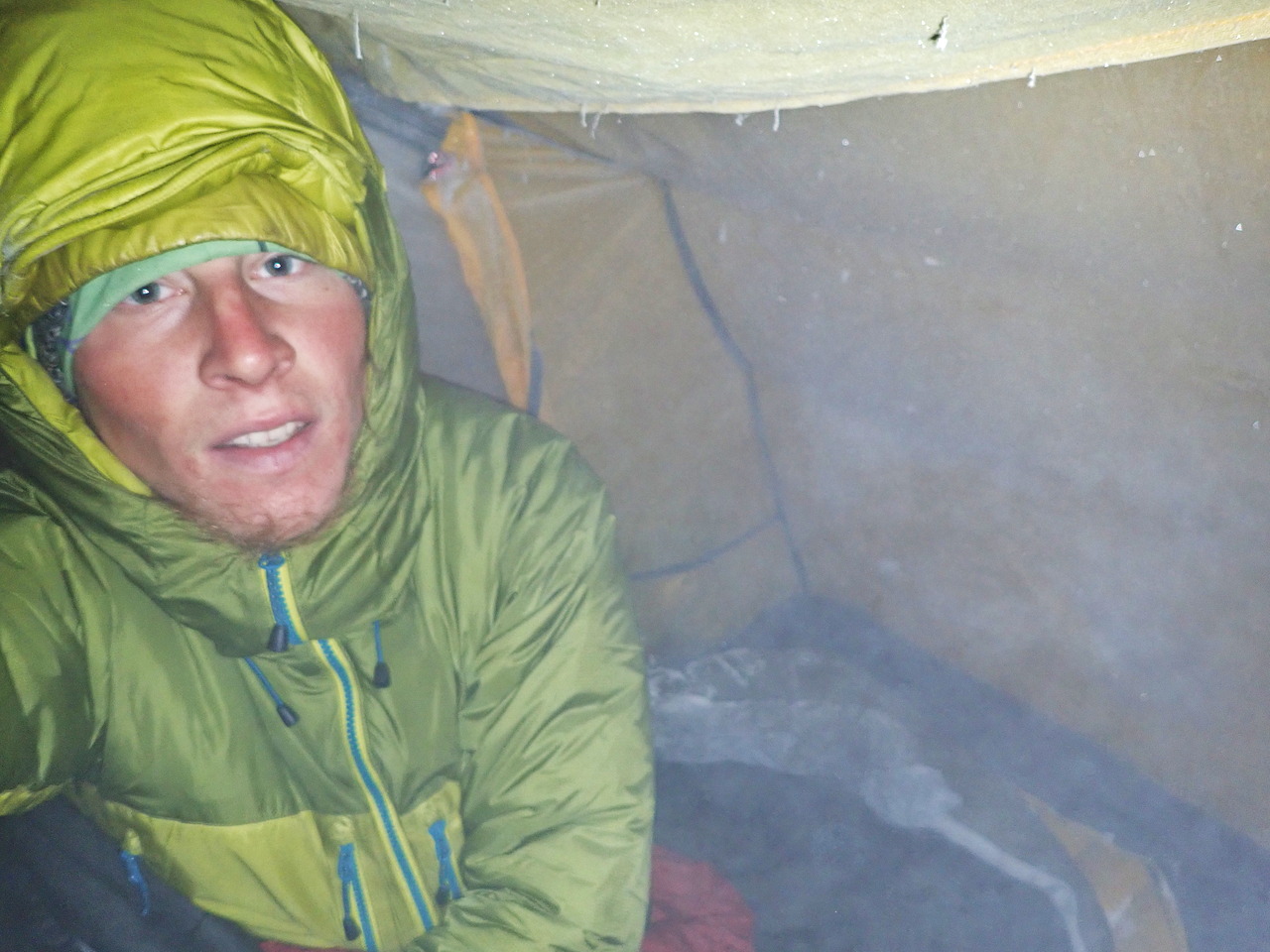
The next day I repaired the hole in the tube, packed my dry tent and left the station from the firefighters. The weather stayed cold for one more week. During this week, I damaged the zipper of my fleece mid-layer. I still could use the lower two thirds from the zipper, but I couldn’t close it on top anymore. Unfortunately, I didn’t realize that my neck wasn’t covered anymore like that – that’s how I got a little frostnip on my neck. I cycled to Kemerovo, where I could stay with Sergej, a friend of Juri from Barnaul. Sergej spoke neither English nor German, but we still could communicate. My stoves needed to be repaired one more time. I had found out that one of the problems of the stoves was the valve on the fuel line because it was leaking there. But this part of the stove isn’t supposed to be a problem at all because it’s neither mentioned in the manual that there is an O-ring that might need to be replaced, nor does the manufacturer Primus provide a matching O-ring in their service kit. Sergej helped me to deal with the problem and found a shop where I could replace the broken O-ring and buy some spare ones as well. I also bought another synthetic tubular cloth that I used as a collar to avoid getting frostbite.
Getting Famous
A short video clip of me cycling in winter in Siberia, which had been recorded by a car driver, had gone viral a few days earlier in the area of Kemerovo. Even Nadia, the mother from Yernar from Semey, sent me this video because she had seen it somewhere online. So a lot of people “knew” me, speculated online about my whereabouts and wanted to take pictures and videos of me when they saw me on the road. Although that was pretty annoying for me, it also helped me because somehow a cyclist couple, who runs a hostel in Irkutsk, knew that I was on my way to Lake Baikal and they offered me to stay in their hostel for free once I’d arrive in their town.
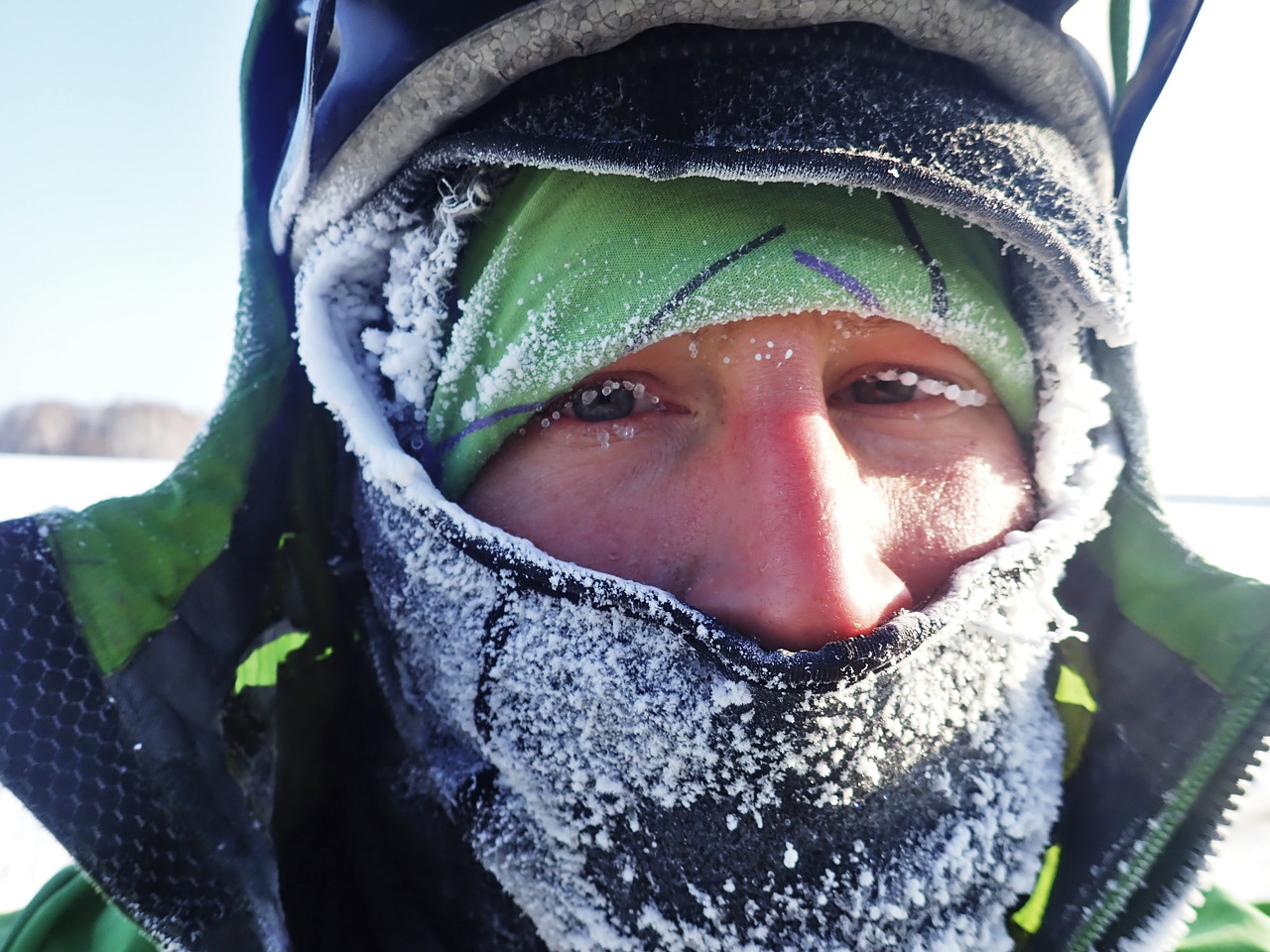
On my way from Kemerovo to Kraynoyarsk, the temperatures excelled -30 degrees again, although in the mornings the thermometer usually still reached -40 degrees. It didn’t feel that cold again, I became less careful and suddenly my nose was frostnipped.
One morning, I realized that I had another flat tire. I removed the wheel and took it inside my tent. I lighted my stove again and started removing the tire from the wheel. Thanks to the burning stove, it was enough to wear my thin gloves because I could always warm my fingers above the stove, thus I didn’t need to wear my mittens which made the repair much easier.
The next morning, I knew, according to the weather forecast, that I just had spent the last cold night in my tent. I decided to throw boiling water in the air and record how it freezes in the air. Unfortunately because of the cold, my camera neither managed to record a video in 4K (high resolution) nor in 120fps (slow-motion), so I had to repeat the whole process three times.
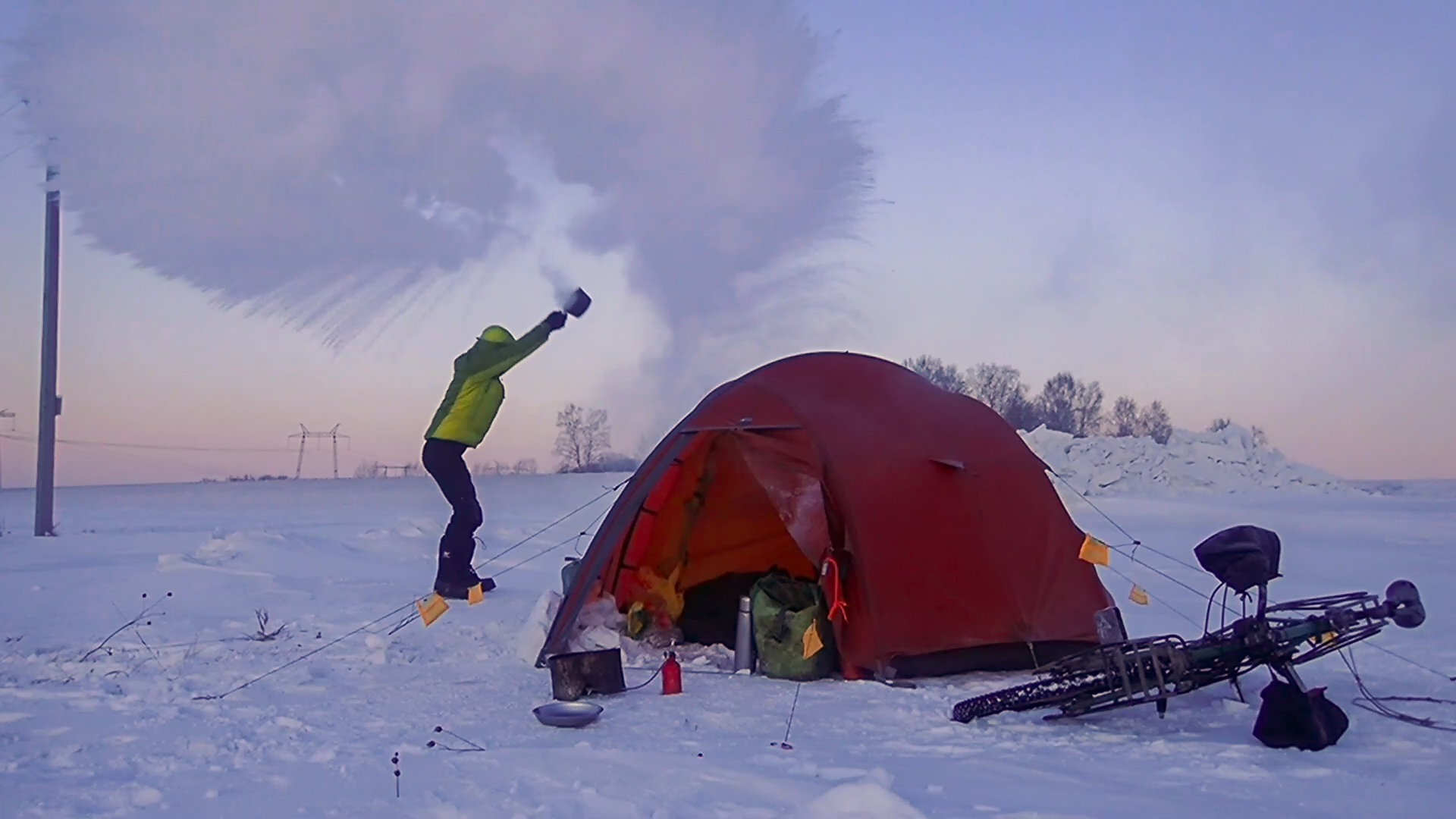
When I reached Krasnoyarsk a few days later, it got already surprisingly warm. I slept in my tent just outside of the town. In the morning, a young woman, Tanya, came to my tent. She wanted to check if I needed help and she even gave me her phone number so that I could call her if I had problems. I took the number, although I thought that I won’t need it because I knew that I could stay in Krasnoyarsk with Olessia, the daughter of Juri’s friend. I didn’t want to cycle 1’000 kilometres from Krasnoyarsk to Irkutsk because the road would be busy and boring. Moreover, I wanted to get to Irkutsk and then to Lake Baikal as soon as possible. So my plan was to hitchhike from Krasnoyarsk to Irkutsk. I could dry up all my equipment in Olessia’s home. Tanya also wanted to help me to get a truck to hitchhike, so in the end, Tanya came to Olessia’s house by car, we could put my bike and all the luggage inside and then Tanya, Olessia and I went to the main road and we found a big rest area with a lot of trucks. The ladies started talking to the truck drivers and they found a father and a son who were driving with their trucks all the way to Vladivostok. They were transporting cars and they agreed to take me and my bike to Irkutsk. We managed to put my bike partially under one car and my bags inside another one and I could travel with to the young man, Yuri, who is the same age as me. We didn’t manage to reach Irkutsk the same day, so we spent the night next to a café and slept in the trucks.
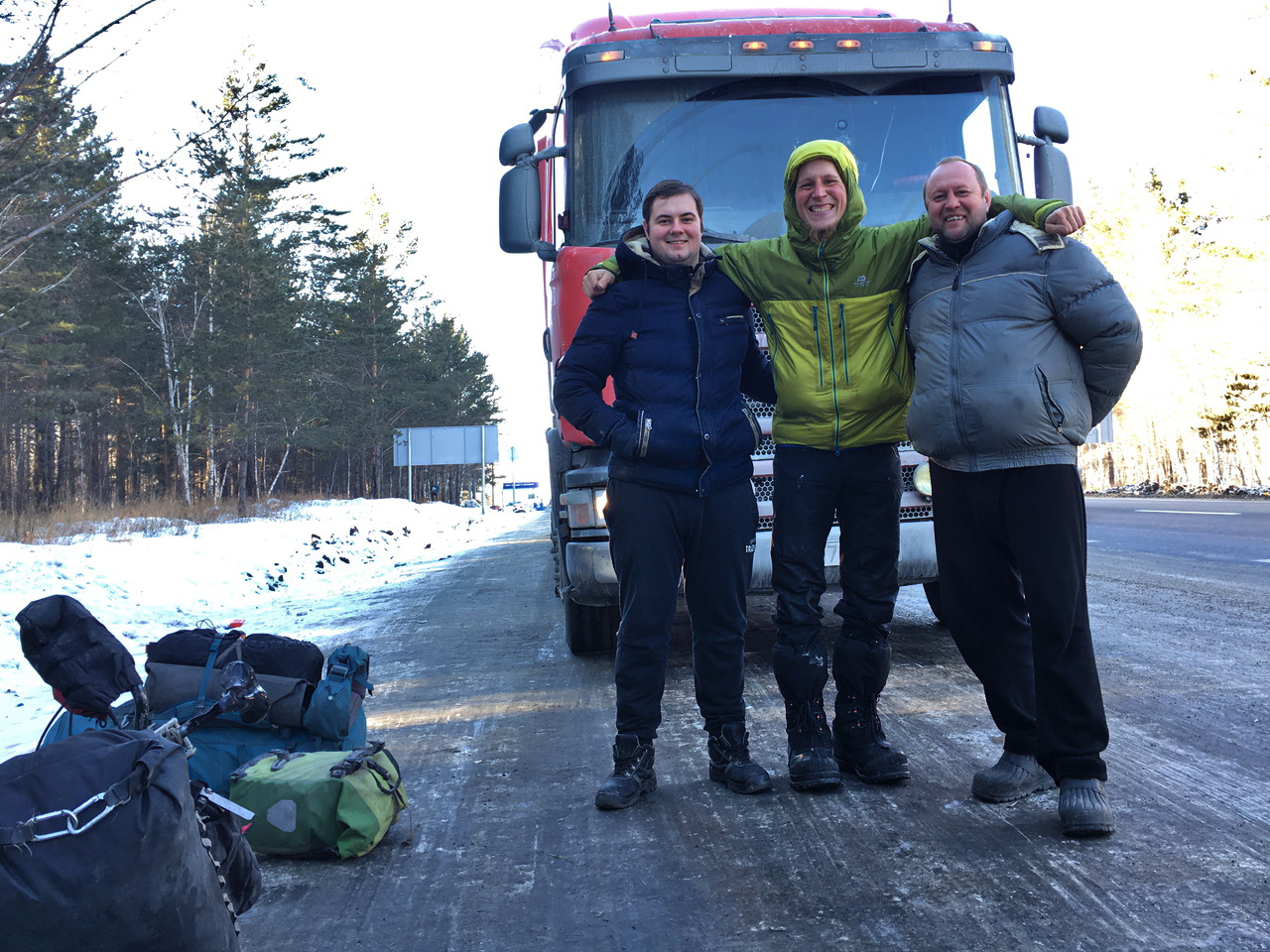
The next day, we arrived in Irkutsk. I cycled the remaining 20 kilometres to the centre of the town to Sasha and Ksenya, the owners of the Tolik hostel that had offered me to stay there for free when they heard that a Swiss cyclist was cycling in Siberia in winter. It was interesting for me to meet cyclists again, and I really apricated the possibility to stay there for free. In Irkutsk, I prepared my next and last leg of my winter journey in Siberia – crossing the frozen Lake Baikal.
